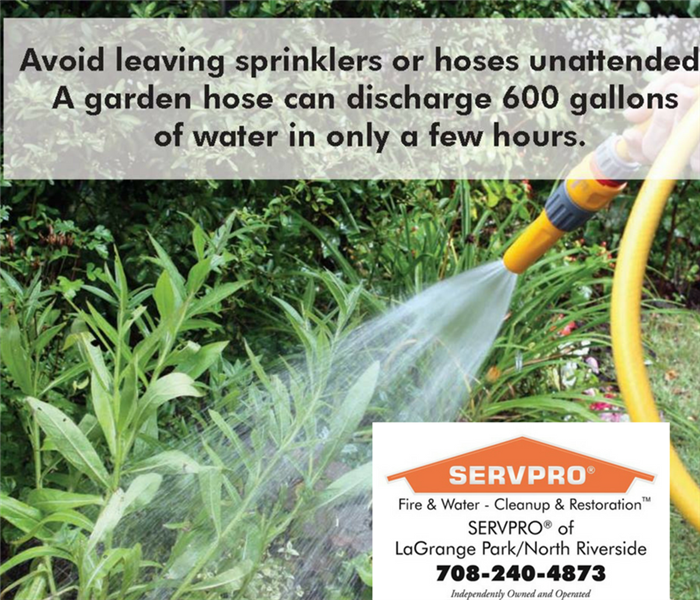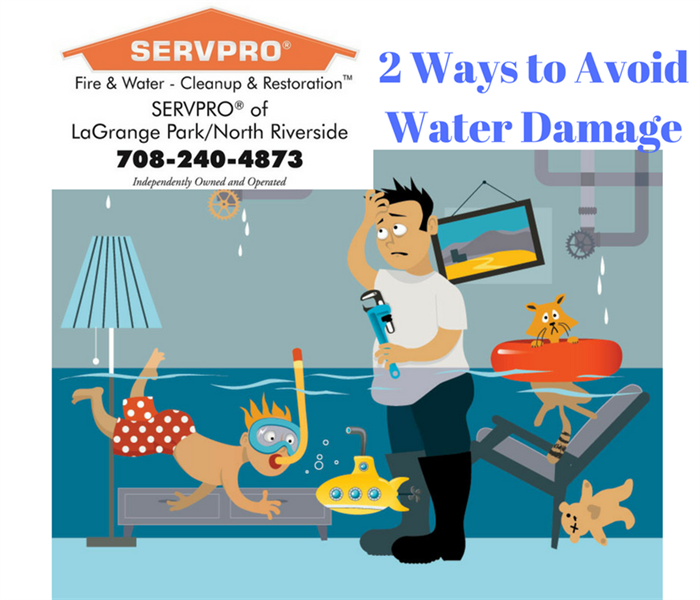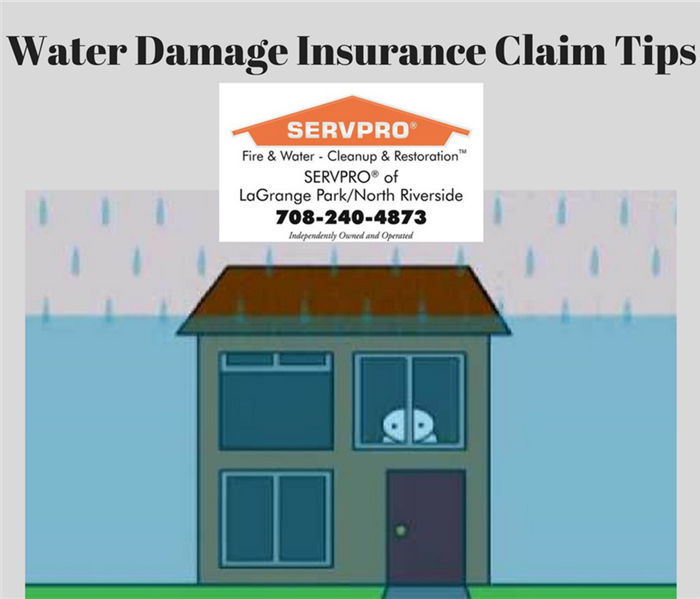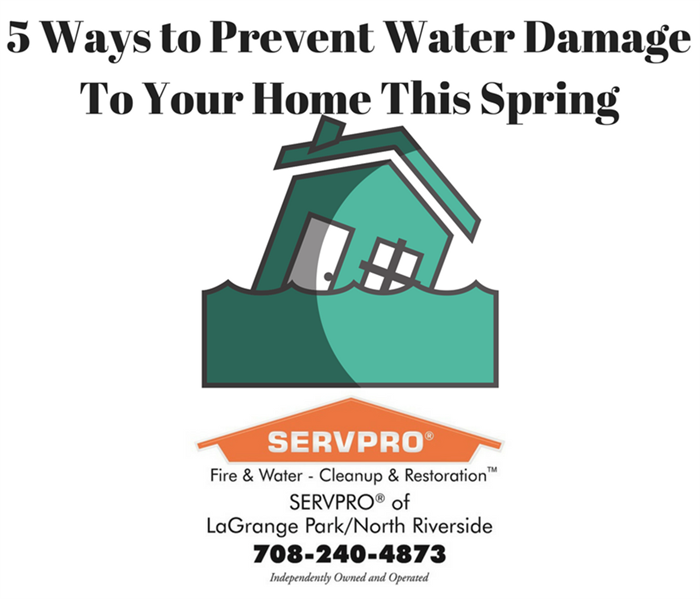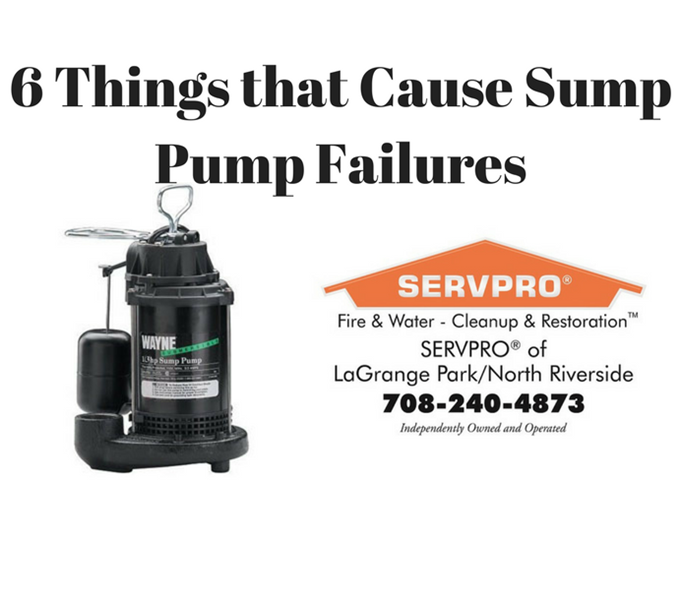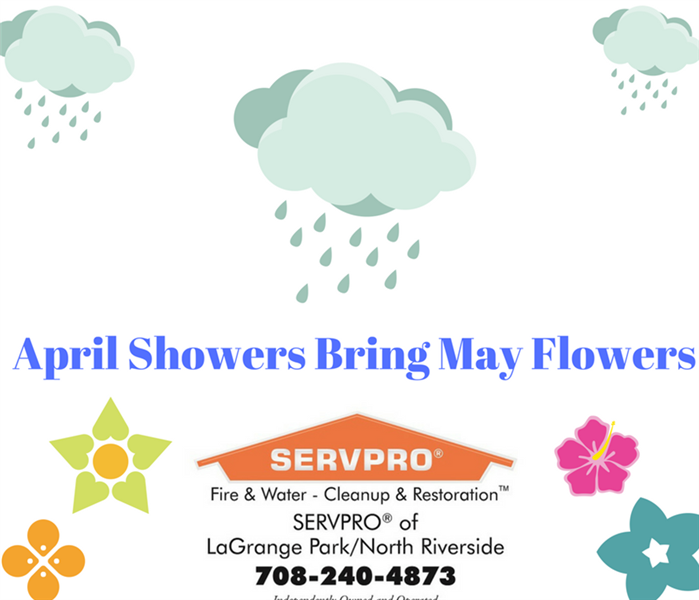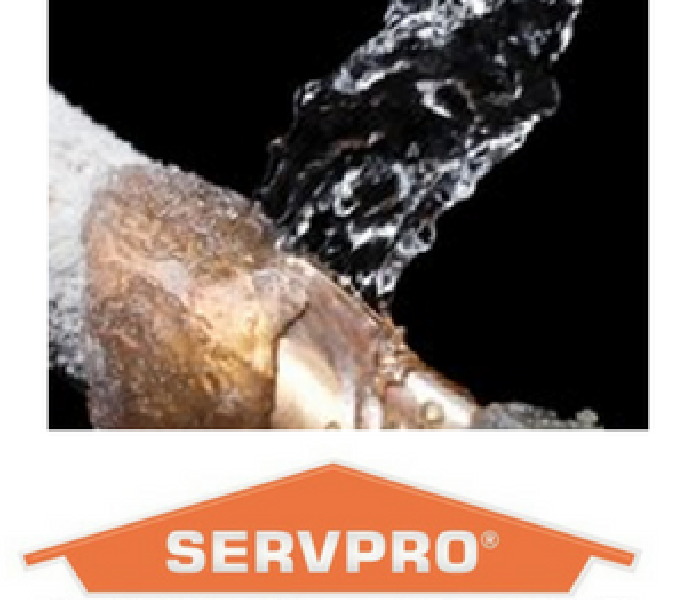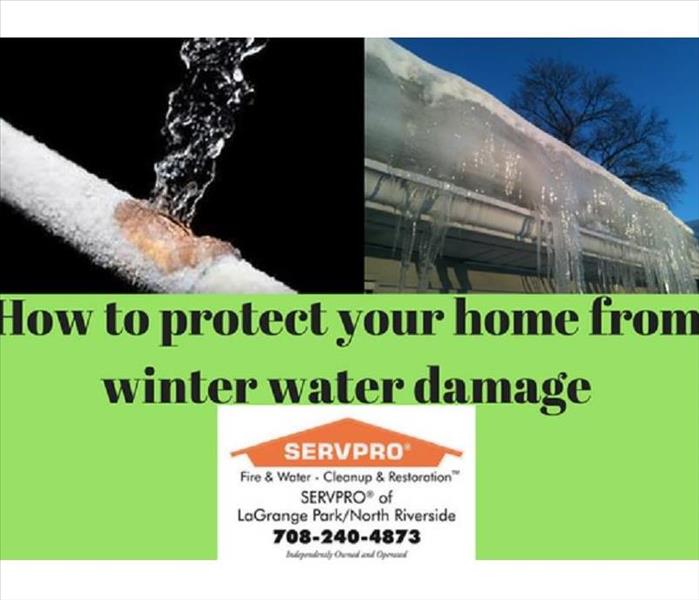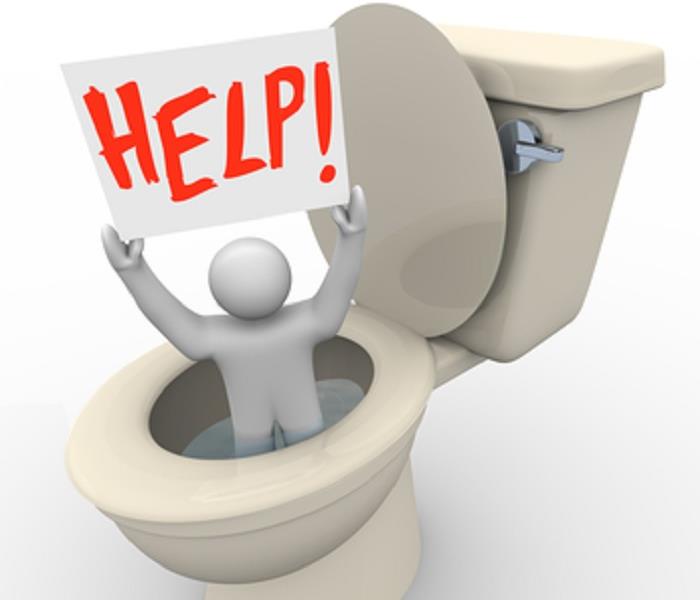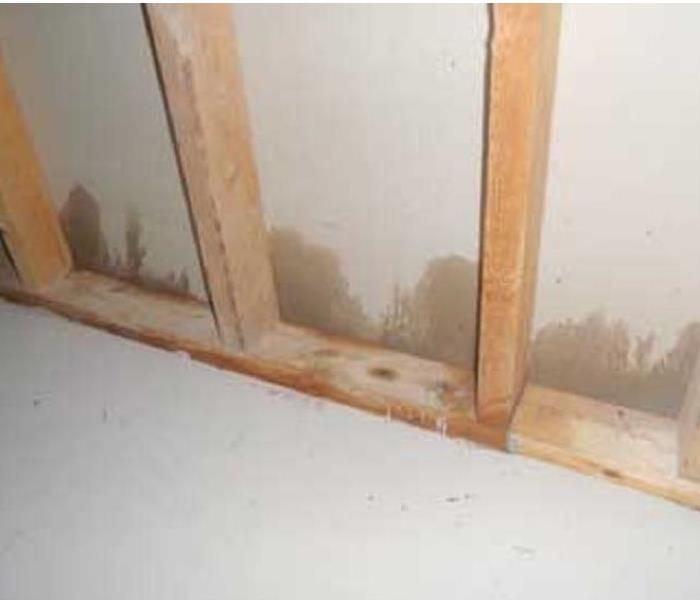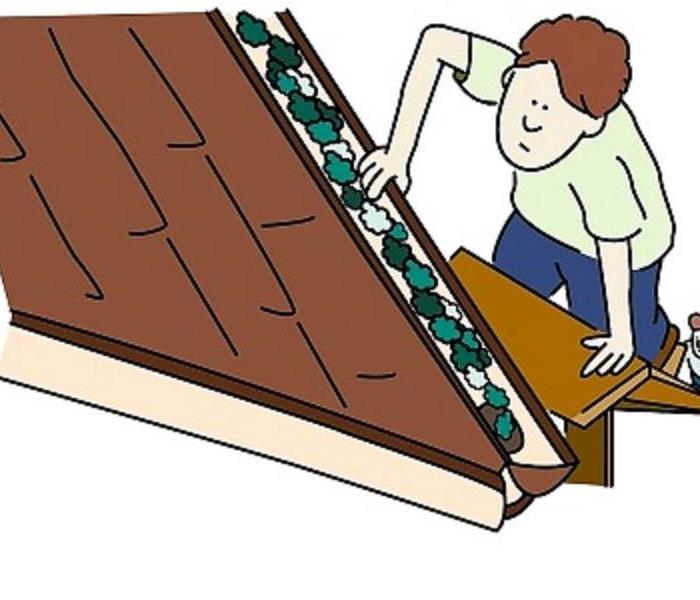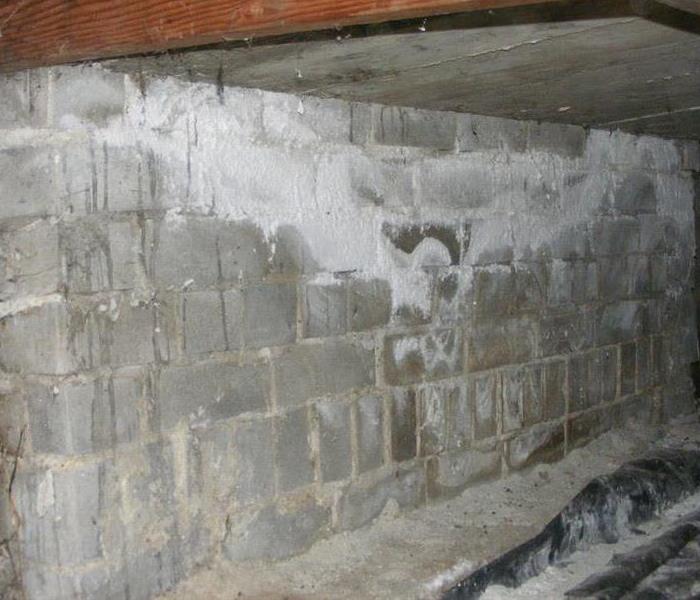Archived Water Damage Blog Posts
Protect Your Home: Preventing Frozen Pipes and Water Damage
1/16/2024 (Permalink)
Winter brings many joys, from cozy nights by the fire to the festive spirit in the air. However, it also brings its fair share of challenges, including the risk of frozen pipes and the potential for water damage. As a homeowner, it's crucial to be prepared and take preventive measures to safeguard your property from these winter woes. In this blog, we will explore the causes of frozen pipes, the resulting water damage, and provide practical tips to prevent such incidents.
Understanding Frozen Pipes: When temperatures drop below freezing, the water inside your pipes can freeze, causing them to expand and potentially burst. This can result in significant damage to your home and belongings, not to mention the inconvenience of dealing with water leaks and repairs.
The Dangers of Water Damage: Water damage caused by frozen or burst pipes can be devastating. It can lead to structural damage, mold growth, and the loss of personal belongings. Repairing water damage can be costly and time-consuming, disrupting your daily life. By taking preventive measures, you can avoid the headache of dealing with these issues altogether.
Preventing Frozen Pipes:
Insulate Pipes: Start by insulating both exposed and interior pipes. Use foam or pipe sleeves to provide an extra layer of protection against the cold.
Seal Drafts: Identify any areas where cold air is entering your home, such as cracks around windows and doors. Sealing these drafts will help maintain a warmer environment, reducing the risk of frozen pipes.
Let Faucets Drip: On exceptionally cold nights, allow faucets connected to vulnerable pipes to drip slightly. The continuous flow of water can prevent pipes from freezing.
Keep the Heat On: Even if you're away from home, it's essential to maintain a minimum temperature of 55°F (12°C). This will help keep your pipes warm and prevent freezing.
Open Cabinet Doors: If you have pipes located in cabinets, open the doors to let warm air circulate around them. This simple act can make a significant difference in preventing frozen pipes.
Disconnect Hoses and Drain Outdoor Faucets: Before the cold weather sets in, disconnect and drain any garden hoses. Shut off the outdoor water supply and drain any remaining water from the pipes to minimize the risk of freezing.
Monitor Thermostat: Install a smart thermostat that allows you to monitor and control the temperature in your home remotely. This will enable you to adjust the heat if temperatures drop unexpectedly.
Conclusion: Preventing frozen pipes and the resulting water damage is crucial for every homeowner, particularly during the winter months. By following these practical tips, you can protect your property from the costly and inconvenient consequences of frozen pipes. Remember, prevention is always better than dealing with the aftermath of water damage. Stay vigilant, take action, and ensure your home remains warm and safe throughout the winter season.
Remember, if you experience water damage due to frozen or burst pipes, don't hesitate to reach out to a professional restoration company like SERVPRO. Their expertise and prompt response can help mitigate further damage and restore your home to its pre-damage condition. Stay warm, stay safe!
Understanding Water Damage
11/3/2023 (Permalink)
Water damage can have devastating consequences for both homeowners and businesses. Whether it's caused by a burst pipe, severe weather, or a faulty appliance, the effects can be far-reaching and costly. In this article, we will explore the causes and effects of water damage, as well as the essential steps to mitigate and restore the affected areas. Additionally, we will discuss how SERVPRO, a leading restoration company, can provide professional assistance during the water damage restoration process.
What is Water Damage?
Water damage refers to the destruction or loss of property caused by the intrusion of water. It can occur in various forms, such as flooding, leaks, or excessive moisture.
Causes and Effects of Water Damage
Water damage can have numerous causes, including natural disasters like hurricanes, heavy rainfall, or even simple plumbing issues within a property. The effects of water damage can range from structural damage, mold growth, and electrical hazards associated with contaminated water.
Steps to Mitigate Water Damage
When faced with water damage, it is crucial to act swiftly to minimize the extent of the damage. Here are the essential steps to take after water damage occurs:
a. Ensure Safety: Prioritize personal safety and turn off the main electrical supply to prevent electrical hazards. b. Remove Excess Water: Use pumps, wet-dry vacuums, or buckets to extract standing water. c. Dry Out Affected Areas: Utilize dehumidifiers, fans, and open windows to promote air circulation and expedite the drying process. d. Assess and Document: Take pictures and document the damage for insurance purposes. e. Seek Professional Help: Contact a reputable water damage restoration company like SERVPRO to assess the extent of the damage and provide professional assistance 1.
SERVPRO's Role in Water Damage Restoration
SERVPRO is a trusted name in the water damage restoration industry. Their services include water extraction, drying and dehumidification, mold remediation, and structural repairs. SERVPRO's prompt response and advanced techniques can help minimize further damage and restore affected areas to their preloss condition.
Water Damage Insurance Coverage
Water damage insurance coverage is crucial in mitigating the financial burdens associated with water-related incidents. It is essential to understand the terms and coverage limits of your insurance policy. Some policies may cover water damage caused by sudden and accidental incidents, while others may require additional coverage for specific events like flooding.
Conclusion
Water damage can be a distressing experience, but with proper knowledge and prompt action, its effects can be minimized. Understanding the causes, effects, and steps to mitigate water damage is crucial for homeowners and businesses. Additionally, seeking professional assistance from companies like SERVPRO can ensure a thorough and efficient restoration process. Remember to review your insurance policy to ensure adequate coverage for potential water damage incidents. Stay informed, be prepared, and act swiftly to protect your property from the harmful effects of water damage.
Check out some of these Insurance companies procedures :
Allstate -
Progressive -
Nationwide -
Amfam.com -
Statefarm-
Fema -
Footnotes: Source : Wikipedia - Water Damage Source: National Institute of health - Water Damage Source: Forbes - Steps to Take After Water Damage Source: SERVPRO - Water Damage Restoration Service Source: Investopedia - Water Damage Insurance Coverage Source: Home Depot - Water Damage Guide
Flash Floods
9/21/2023 (Permalink)
Every year, flash floods affect every state in the US, making them the number one weather-related killer in the country. According to The Weather Channel, floods, which are often characterized as high flows or overflows of water from rivers or similar bodies of water, occur over a longer period of time than flash floods.
Flooding can be caused by various factors. Winter or spring rains, combined with melting snow, can rapidly fill river basins. Additionally, torrential rains from decaying hurricanes or tropical systems can lead to river flooding. An example of this is the Mississippi River Flood of 1993, which resulted from weeks of heavy rain from thunderstorms.
On the other hand, flash floods are sudden and quick-rising floods triggered by heavy rainfall within a short period, sometimes lasting only a few hours. They can also occur due to ice jams on rivers during winter or spring thaws, or even from dam breaks. The influx of water causes a dangerous overflow that can sweep away vehicles, dislodge boulders onto roadways, uproot trees, destroy buildings, and wash away bridges. The speed at which the water rises is particularly alarming.
Coastal flooding, on the other hand, occurs when strong onshore winds push water from the ocean, bay, or inlet onto land. This can happen during tropical storms and hurricanes, resulting in storm surges, or even during non-tropical storms like "nor'easters."
SERVPRO of LaGrange Park/North Riverside specializes in flood and storm damage restoration, which forms the foundation of our business. With extensive training in water damage and storm restoration, we are equipped to swiftly restore your home to its normal state.
What to Do During a Broken Pipe
9/6/2023 (Permalink)
A broken pipe can be a major inconvenience and costly to repair. It is important to take action quickly to minimize the damage. Here are the steps to take if you have a broken pipe:
- Locate the shutoff valve. The shutoff valve is the main control for the water supply to your home. It is usually located near the water meter, inside or outside your home.
- Turn off the water. Once you have located the shutoff valve, turn it off to stop the flow of water.
- Open all faucets. This will help to relieve the pressure in the pipes and minimize the amount of water that comes out of the break.
- Drain the water. If possible, use a wet/dry vacuum to remove as much water as possible. You can also use towels or buckets to soak up the water.
- Remove non salvageable damaged materials. Any porous materials that have been wet and permanently damaged by the water should be removed as soon as possible. This includes things like carpet, drywall, and furniture.
- Set up fans and dehumidifiers. This will help to dry out the area and prevent mold growth.
- if possible call in a professional like SERVPRO La Grange Park/North Riverside to determine extent of damage and best course of action to minimize secondary damage
Preventing Broken Pipes
There are a few things you can do to prevent broken pipes:
- Insulate your pipes. This will help to keep them from freezing in the winter.
- Check your pipes for leaks regularly. If you find a leak, fix it immediately.
- Avoid using sharp objects near your pipes. This could damage them.
- Have your pipes inspected by a plumber every few years. This will help to identify any potential problems early on.
By following these tips, you can help to prevent broken pipes and the damage they can cause.
Here are some additional tips for dealing with a broken pipe:
- Take pictures of the damage. This will help you to document the extent of the damage and make it easier to file a claim with your insurance company.
- Be prepared to provide proof of ownership of your home. This could include a copy of your deed or mortgage.
- Keep all receipts for repairs and materials. This will help you to get reimbursed by your insurance company.
- Be patient. It may take some time for your insurance company to process your claim and approve the repairs.
By following these tips, you can minimize the stress and hassle of dealing with a broken pipe.
Illinois Chicagoland Areas are under danger from extreme heat and severe weather storms!
7/5/2022 (Permalink)
ABC 7 Chicago reports Tuesday morning residents are left without power as strong storms moved throughout the region. Winnebago, Lake, Cook County, and more are on high alert for storms that could produce damaging winds at up to 70 miles per hour.
This comes only weeks after a damaging supercell swept throughout northeast Illinois and northwest Indiana. The June 13th storm produced strong winds reaching up to 84mph and hundreds of trees being uprooted, downed, or damaged. Bellwood and Broadview experienced some of the most damaging effects of the storms. Many were left without power as a heatwave as Broadview and Bellwood join Westchester in declaring the villages in a local state of emergency. As SERVPRO launched into our communities to provide assistance to those in need we learned quite a bit of information to help you prepare for a natural disaster. So here are some tips and tricks to help you prepare for a rise in temperatures.
Stay hydrated. You don’t need to wait until you’re thirsty to drink. Sipping water throughout a hot day can help you remain hydrated and keep fluids high
Dress for the weather. Wearing light, loose-fitting clothing can ensure your body is able to breathe and allow a cool breeze to lower your body/skin temperature.
Staying inside. Remain in a cool or air-conditions environment. During the following days of the Illinois supercell, many villages opened cooling stations and busses. Those who lost power during the supercell were able to stay cool while the city worked to restore power to homes.
References:
Earnest, A. (2022, July 5). Dangerous Heat, Storms Before 'Pneumonia Front' In Illinois. Across Illinois, IL Patch. Retrieved July 5, 2022, from https://patch.com/illinois/across-il/dangerous-heat-storms-pneumonia-front-illinois
Team, A. C. D. (2022, July 5). Chicago weather forecast includes extreme heat after thunderstorms knock out power for thousands. ABC7 Chicago. Retrieved July 5, 2022, from https://abc7chicago.com/chicago-weather-forecast-tornado-warning-thunderstorm/12020208/
Spring in Chicagoland area
3/22/2022 (Permalink)
As we step into spring and the days get longer the weather temperature begins to rise to melt away our winter wonderland. Melting snow and spring showers water blooming flowers. Changes in weather are natural and beautiful but for the unprepared can be disastrous. Melting snow, rainfall, and humidity create the perfect environment for floods, mold, and water damage. We at SERVPRO in La Grange Park have you in mind during this time and would like to help you prepare for the upcoming weather changes with some preventative measures to keep you and your home protected against water damage.
The First step to prevention is being able to identify common areas water damage is likely to occur and signs of water and moisture damage. Areas where water can build, are a great place to start. Flower beds, ponding depression areas (U-shaped areas) and slanted yards, poorly maintained roofing and gutters, and cracks in your foundation and walls are open invitations for water damage.
The second step is tending to these areas. Consider regarding your lawn or installing a drain to help the flow of rainwater away from your home. Your gutters should be regularly cleaned and serviced. Cracks in your roofing and foundation could possibly be filled with epoxy but should really be looked at by a professional. Plumbing leaks should also be checked by a professional. Luckily SERVPRO of La Grange Park is here to help. Please feel free you contact us at (708) 240-4873. Check out our what to do after a flood for more information on mold control.
9 Ways to Keep Your Home Safe From Water Damage
3/12/2022 (Permalink)
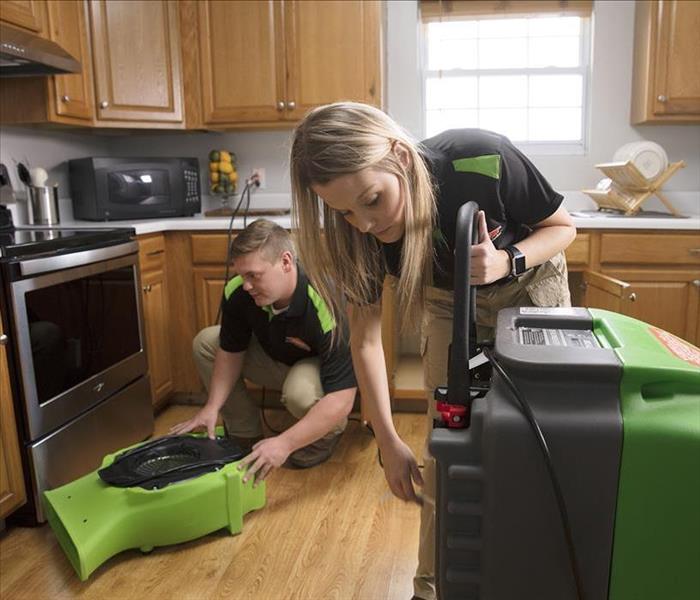 Minor leaks can go undetected for a long time and cause significant damage if left unchecked.
Minor leaks can go undetected for a long time and cause significant damage if left unchecked.
- You should be aware of the location of the stopcock. Ensure that not only you but also your family members are aware of its location. A severe leak or rupture can cause significant damage in minutes. It is critical to understand where and how to turn off the water supply.
- Check for leaks ahead of time. Minor leaks can go undetected for a long time and cause significant damage if left unchecked. Consider that a dripping faucet can waste up to 57 gallons of water per week. Look for signs of stray water beneath sinks and around appliances such as dishwashers and washing machines.
- Check that your sump pump is operational. The sump pump, which is common in basement homes, plays an important role in ensuring that your basement does not flood after prolonged periods of rain. If you have one, make sure it's well-maintained and serviced at least once a year.
- Keep debris out of your gutters. While leaves are the most common cause of blocked gutters, this isn't just an autumnal problem. Moss and weeds are frequently discovered to be a major cause. Blocked gutters play a significant role in damp problems. If you see water running down the side of your house or if your gutters appear to be sagging, they're probably blocked and need to be cleaned.
- Inspect your roof from the inside out. Examine the inside of your attic for signs of water leaking through the roof. Examine the joists for damp spots and the plaster for tea-colored stains. Outside, look for visible damage to the roof and make sure the flashing around any chimneys is in good condition.
- Keep your pipes from freezing. Even if you plan to be away, use a smart thermostat to keep your home at a minimum temperature of at least 10 degrees Celsius. Warm water must be able to circulate through pipes to avoid freezing damage. If a property will be unoccupied for an extended period of time, turn off the water supply at the stopcock and consider draining the system so that no water remains in the system.
- Pipes that are exposed should be properly insulated. Snap-on pipe insulation is inexpensive and effective, and it can also be used outside.
- Install a device to detect water leaks. Detection devices, which are relatively inexpensive, cut off the water supply in the event of a leak, which is critical if you leave your property vacant for extended periods of time.
- Look for any signs of moisture or mold. Damp can be detected by flaking paint or wallpaper, as well as black, speckled marks on skirting and sills. Consider adding more insulation if your walls feel cold to the touch or if you notice a musty odor. In the mornings, check windows and skylights for condensation. Its presence can indicate that your home has higher-than-average moisture levels.
How to Protect Your Property from Floods Caused by Snowmelt, Ice Jams, and Winter Storms
1/31/2022 (Permalink)
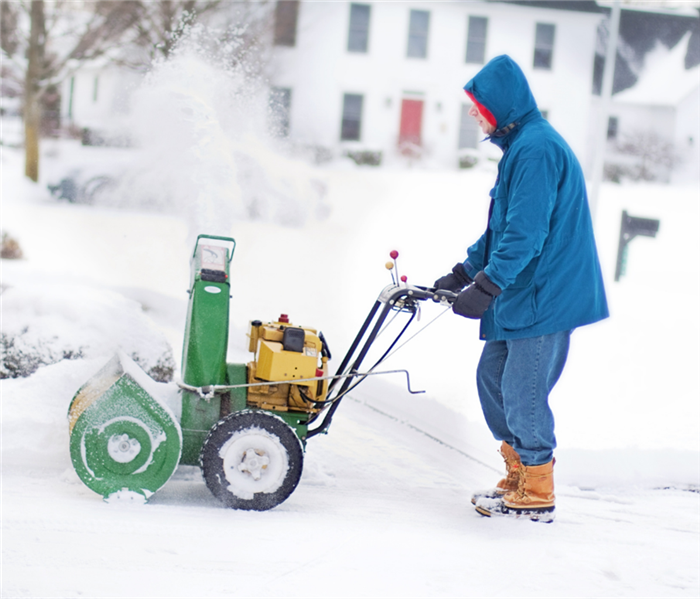 The risk of flooding doesn't go away in the winter.
The risk of flooding doesn't go away in the winter.
When we hear about flooding in the news, we usually hear about spring floods and summer storms, giving the impression that flooding occurs just half of the year. We're not out of the woods yet.
The risk of flooding doesn't go away in the winter, and flooding isn't the only thing to be concerned about when the weather turns cold. Snowmelt, ice jams, and winter storms threaten major floods from the Pacific Northwest to the Great Lakes to the Northeast throughout the winter months.
Winter Flood Risk #1: Snowmelt
Snowmelt is an element of the natural water cycle. However, if snow thaws too quickly to be absorbed back into the soil, neighboring water bodies, and drainage systems, it can flood adjoining land, potentially flooding your basement.
Snowmelt floods can occur anywhere in the snowy north of the US, and they usually occur in small, isolated episodes. But that doesn't rule out the possibility of serious consequences. Let's pretend it snows ten inches, which isn't unheard of in freezing areas. One inch of water equals ten inches of snow, and an inch of floodwater can cost you up to $25k in repairs, according to FEMA.
While snowmelt risk is higher in the spring, climate change has introduced more and more unseasonably warm temperatures every winter. Take the 2019 Midwestern floods, for example. Record amounts of snowfall from January through March were followed by a three-day stretch of 60-degree weather. Rain fell and caused historic levels of flooding along the Missouri River and its tributaries.
Winter Flood Risk #2: Ice Jams
Long cold episodes that cause the surface of rivers to freeze are followed by warm spells, resulting in ice jam floods. Large pieces of ice break off unevenly as temperatures rise, blocking streams and flooding adjacent settlements.
Winter Flood Risk #3: Winter Storms
People who live in lakeside places like the Windy City are probably familiar with flooding in the winter. Strong winds from winter storms can create massive waves that crash over shorelines and barriers into city streets, as they did in Chicago last winter.
These winter storms and subsequent floods are common in the Midwest along the Great Lakes, but they also happen along the East Coast. Nor’easters can trigger storm surges that push heavy ocean tides into coastal communities, on top of heavy rain or snow.
Regular downpours and flash floods can happen throughout the winter, too, as long as temperatures are high enough.
Steps You Can Take This Winter to Prevent Flooding on Your Property
The easiest method to protect your property from a flood is to put measures in place before one occurs. The two most important actions to take care of to ensure that you have both financial and structural flood mitigation on your property.
Step 1: Secure Flood Insurance
Purchase flood insurance as soon as possible once the fear of floods has passed. That way, if you experience flood damage this winter, you'll be able to file a claim swiftly and easily.
The good news is that a flood insurance policy covers all sorts of flood damage equally, so your policy will provide coverage all year. The cost of coverage is decided by factors such as the age of your structure, the type of foundation it has, and your flood zone and risk level.
Step 2: Shovel Proactively and Test Drainage Systems
Shovel snow away from your foundation by at least five feet.
Shovel snow away from a runoff path if your property is on a slope or hill.
Remove any snow that has accumulated on your roof.
Keep snow and ice from accumulating around your property's drainage systems, such as gutters and groundwater pumps.
A bucket of water can be used to test sump pumps.
Floods caused by snowmelt, ice jams, or winter storms can be helped with the same wet and dry floodproofing measures you take to safeguard your property against spring and summer floods, such as constructing drainage systems.
How do I protect my water heater in cold weather?
12/1/2021 (Permalink)
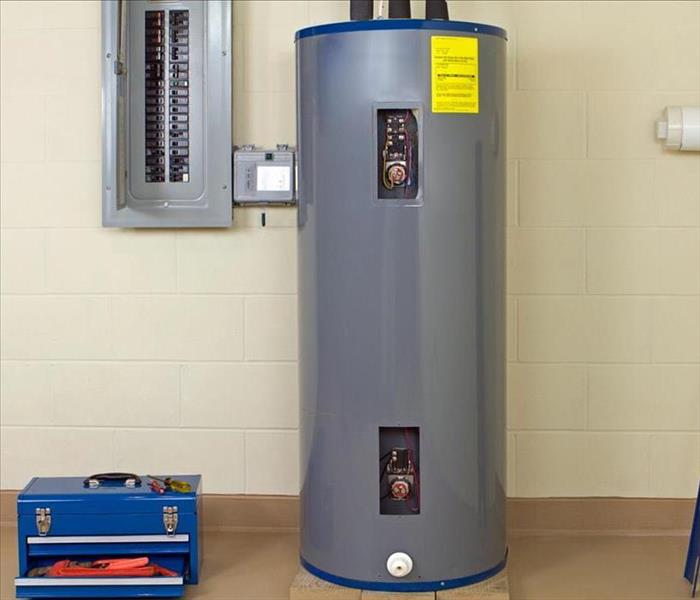 Tips on how to prepare your water heater for the holiday season
Tips on how to prepare your water heater for the holiday season
This holiday season, having a damaged water heater is the last thing you want. Dishes are more difficult to wash when you have to heat water on the stove, and guests don't like cold showers. However, you may be on the verge of a water heater meltdown without even realizing it.
The water in your plumbing is colder now that winter is near. This implies that your water heater will have to work a little longer and harder to reach the desired temperature. Furthermore, the temperature difference between the hot water at the top of the tank and the cold water at the bottom is higher, forcing the tank to flex more.
With the return of the kids from college, the arrival of family for an extended visit, the additional holiday dishes, and laundry, it will be put to even greater use. If your water heater is older, this could cause it to overheat.
Here are tips on how to prepare your water heater for the holiday season
Insulate your water tank and pipes.
As the temperature cools, it's critical to maintain your hot water as hot as possible. Loss of heat can drive up utility costs by consuming more power and gas. Heat loss can be reduced by insulating the tank and pipes going away from the water heater. This insulation is generally built into newer water heater tanks, but if you have an older tank, you can buy a tank cover to add an extra layer of insulation to keep hot water hotter. Your plumber will be able to properly measure and install this tank insulation. Otherwise, if you're in the market for a new water heater, look into one of the newer tank heaters with built-in insulation.
Check the anode rod.
The sacrificial anode rod is an important component of tank water heaters because it rusts away and sacrifices itself to prevent rusting in the heater tank. The sacrificial anode rod is placed at the top of the tank and should be checked during the pre-winter inspection. Anode rods are good for five years, although they should be examined once a year. It's time to replace the rod if it's calcium-coated or worn down to less than 1/4 inch thick.
Clean out the tank.
Excess sediment and calcium buildup can coat the tank sides lowering its efficiency and resulting in less hot water. You want to make sure your water heater is running smoothly and efficiently before the colder months of the year arrive. To eliminate buildup and extend the life of the tank, hot water tanks may need to be drained 1-2 times a year. Turn off the water, gas, and electricity to drain the tank. Connect a hose to the drain valve and direct the water to a ground drain. Allow the tank to drain by opening the drain valve and the temperature-pressure regulator valve. Once the tank is empty, flush it with cold water to remove any remaining sediment. Your plumber can also assist you in checking for calcification on the water heater element.
Access the temperature pressure regulator.
If the temperature or pressure in your tank rises too high, this valve on the top or side of the tank automatically releases water. Lift the lever and then release it to inspect the valve. You should be able to hear or see water exiting from the system. If the valve isn't working or the water is still leaking, call your plumber for assistance.
7 Ways to Prevent Frozen Pipes
12/1/2021 (Permalink)
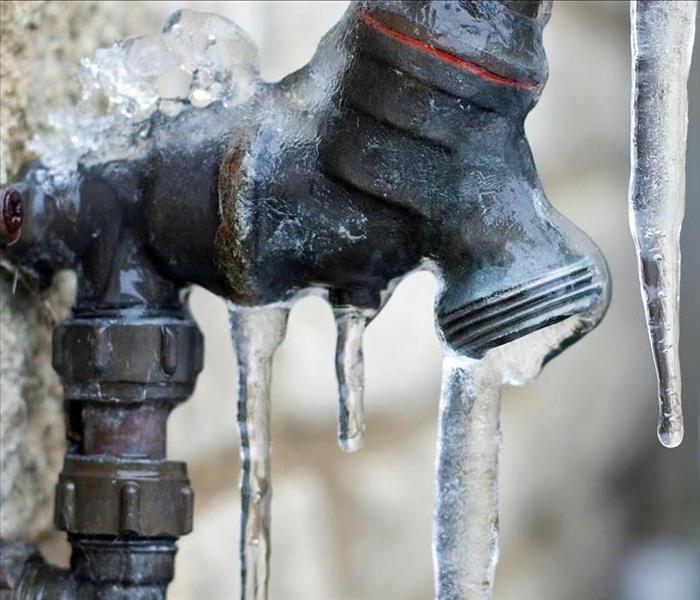 Tips to help prevent pipes from freezing
Tips to help prevent pipes from freezing
Frozen pipes are caused by three factors: rapid temperature dips, insufficient insulation, and thermostats set too low.
- Insulate. Even if you live in a climate where freezing is unusual, pipe insulation in your home's crawl areas and attic can help. The pipes that are exposed are the most vulnerable to freezing. Remember that the more insulation you use, the better your pipes will be protected.
- Use heat tape or wire. Wrapping pipes with heat tape or thermostatically controlled heat wires is one option. Use only goods that have been approved by a third-party testing organization, such as Underwriters Laboratories Inc., and only for the purpose indicated (exterior or interior). Follow the manufacturer's installation and operation directions to the letter.
- Seal leaks. Locate and completely plug any leaks that enable chilly air to enter the house. To keep the cold out, look for air leaks around electrical cables, dryer vents, and pipes and seal them with caulk or insulation.
- Hoses, valves, and faucets should all be secured outside. Disconnect garden hoses and, if possible, use an interior valve to turn off and drain water from pipes running to outside faucets before winter arrives. This decreases the risk of freezing in the short distance between the home and the pipe.
- Allow the water to drip. It may only require a trickle of hot and cold water to keep your pipes from freezing. When the weather is cold, let warm water trickle from a faucet on an outside wall overnight.
- Make the necessary adjustments to the thermostat. Frozen pipes can also be avoided by keeping your thermostat at the same temperature throughout the day and night. This also helps to lessen the strain on the furnace during periods of extreme cold.
- Open Cabinet doors. This permits heat to reach pipes under sinks and appliances near outside walls that aren't insulated.
Water not coming out of the faucet is one of the first indicators of a frozen pipe. If you notice this, go to the basement and double-check that the water is still on and that there isn't a leak. Continue your check after you've confirmed these two points to ensure that none of your pipes have burst. If you discover that your pipes are frozen but none have burst during your search, you have two options:
- Call a plumber to thaw your frozen. This is usually a better option. You don't know where the frozen pipes are or you can't get to the frozen region if you don't think you can safely thaw the pipes yourself.
- Make an effort to thaw the frozen pipes on your own. Be advised that if this option is not done correctly, it can cause more complications.
What causes sewage back up!
9/13/2021 (Permalink)
Sewage back ups are very unfortunate events that can happen in any home or commercial property. What causes this type of water damage anyway? Well, typically there are three main categories that a sewer back up happens: damaged sewer pipes, clogs, and tree roots in the sewer system. Let's look at these three areas a bit closer.
- Clogging: Typically if you only have one area of your home that experiences a backup, like a tub or a sink, then there is typically a clog and can be fixed with cleaning the drain. However, if you have the backup in several areas of your home, then there is a blockage at the main or the private that is causing the issue. Unless the blockage is removed, the overflow will continue and will damage your entire home or business area.
- Tree Roots: The roots of large trees in the proximity of a sewer line can often cause severe problems. They can literally grow into the pipes and cause holes and blockages or they may wrap around the sewer line and crush it.
- Damaged Sewer Lines: Older properties with older sewer lines that have not been upgraded can have broken or collapsed lines. All the pipes and sewers in older homes were built using cast iron and clay which can wear off with time, get rusty, and easily break down. Present day plastic sewer lines cannot cause such problems simply because they don’t rust.
Sewage backups are not only hazardous to your health, but they can cause a great amount of structural damage to your home. If you experience a sewage back up do not attempt to flush the toilet. Do not use harsh chemicals to attempt to clean out the drain. This can actually cause more damage and make things worse. Open your windows to let fresh air in. It is also very important to keep pets and children away from the affected area. However, the most important thing to do, is to call for professional help. We here at SERVPRO are always here to help!
Midwest Tornado & Flood
7/7/2021 (Permalink)
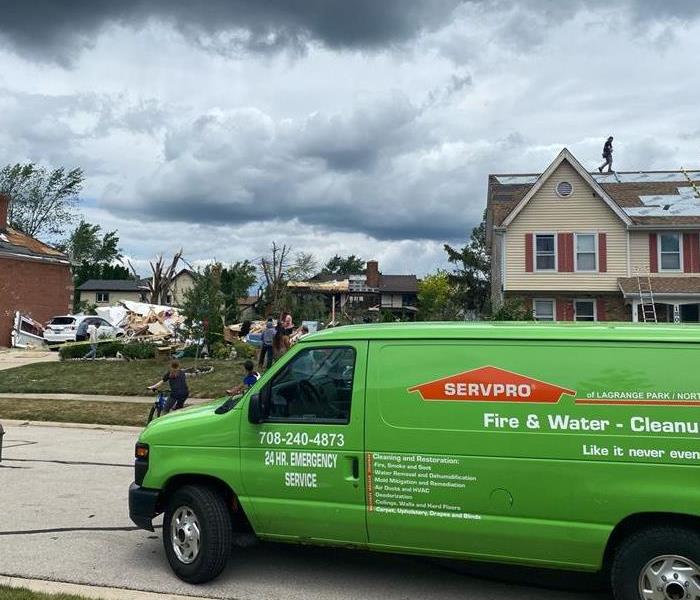 Serving the community!
Serving the community!
Living in the Midwest, you don't hear of many tornadoes coming through the area. If they do, they are mostly more south and don't cause much damage. However, disaster struck two of our suburbs in the middle of the night. The only time we usually hear the tornado sirens go off is when the first Tuesday of the month comes around. However, this was not the case this time. Once the morning hit, we where all able to see the disaster that the tornado has caused to residential homes. There where trees in homeowner's yards that where not there's, trampolines through the side of homes, cars completely smashed, and even an entire home was destroyed. We here at SERVPRO knew that the community needed our help. We immediately stationed our crew in two suburbs that where affected the most, and just handed out water and snacks to anyone that was in need of them. We could see the devastation on people's faces, and all we wanted to do was help as much as we could.
Following the tornado that hit, we then received major flood warnings for almost two weeks. On top of all the homes having property damage to them, they where now dealing with heavy rain fall coming into their homes. This is where our storm team kicked it into gear. Our crew is working around the clock to help restore people's homes, and to give them guidance on what the next step is to take because of these disasters. We can't be more proud to help support our communities during this time. This is why we stand by our saying of being "Faster to Any Size Disaster".
Melting snow floods basements
3/12/2021 (Permalink)
 Here are some tips!
Here are some tips!
As we begin to enter Spring season, the process of snow melting can cause water damage to homes and businesses. This will then lead to flooding. It could be minor or major, but still cause water damage problems. Here are some ways to help prevent water damage as we enter this spring thaw out season. Now, you may not be able to prevent water damage under ever circumstance, but you can prepare your home ahead of spring-thaw months to prevent common causes of damage.
1. Basement pumps- install a sump pump or sewer backflow value and keep a battery-operated backup in case of power failure. Also, make sure to consider installing a water alarm that warns when water is accumulating in your basement.
2. Basement storage- Make sure to keep valuable items out of your basement. Removing any electronics or stored valuables from your basement prior to spring-thaw warnings could prove to be an important ounce of prevention.
3. Debris removal- Be sure to remove debris from window wells, gutters and downspouts.
4. Doors and windows- Check for any leaks around doors and windows.
5. Exterior walls- Keep all exterior walls of your home well painted and sealed.
6. Flood drains- If you have flood drains, make sure they work properly.
7. Foundation cracks- Make sure to inspect your foundation for cracks that will allow water seepage and initiate repairs.
8. Fuel tanks- Permanently anchor any fuel tanks.
9. Grading- inspect the grading around your home and make any changes. Design the grading to encourage the water to flow away from your home.
10. landscaping- Make sure to trim trees and bushes away from your home and do not store wood or compost piles nearby.
11. Roof- Keep your roof in good repair. Unless a tree falls on your roof during a storm, most insurers expect you to maintain your roof to prevent water leaks caused by snow melting or torrential downspouts.
Whether you are able to control the situation or not, we here at SERVPRO are always here to help you get your home or business back to like the disaster never even happen. That is way we are always here to help!
Frozen Pipes
1/31/2021 (Permalink)
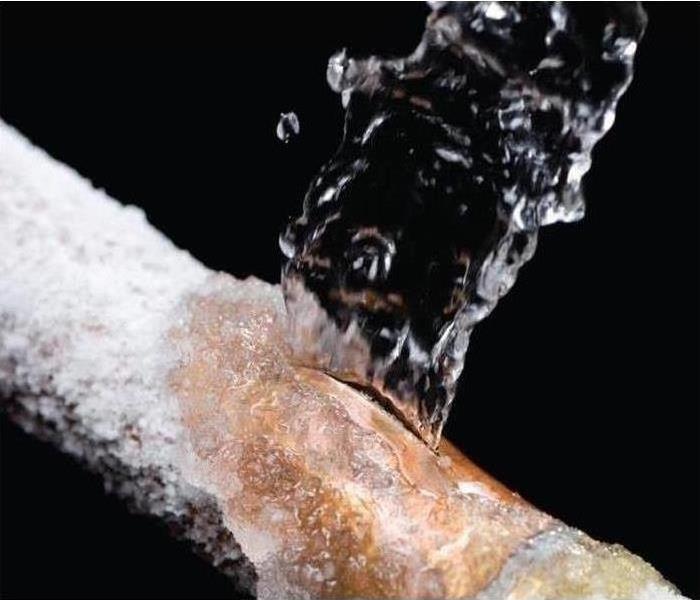 Frozen Pipe
Frozen Pipe
Thawing a frozen pipe the correct way is crucial to minimizing the damage. In order to thaw a frozen pipe, you need to first determine which pipe or pipes are frozen. You can do this by turning on the faucets, and if no water comes out or only a slight trickles out, then you have a frozen pipe. Before you begin attempting to thaw a frozen pipe, you need to open the faucet that the pipe feeds water into. You need to make sure to open both the hot and cold handles. This then will help relieve pressure in the system, and then will allow the water to escape once you begin to thaw the pipe. When beginning to thaw the pipe, you should always start near the faucet then work your way down to the blockage. This will help ensure that the melting ice and steam is able to escape through the open faucet. If you start the thawing process closer to the blockage, the melting ice could get stuck behind the blockage, creating more pressure in the pipe and increasing the chances the pipe will burst. When it comes to thawing the frozen pipe, you could use a hair dryer, heat lamp or portable space heater, hot towels, or electrical heating tape. If the frozen pipe is enclosed, you will need to either turn the heat up in the property, infrared lamp, or cut out a section of the wall to thaw out the frozen pipe/pipes. Remember NEVER attempt to thaw a pipe using an open flame. This can not only damage the pipe, but it can also start a fire in your property. If the frozen water pipe does burst, the first thing you should do is shut off the main water line into your property. This then will prevent additional water from flowing and damaging your property. Then you will need to call a professional, like SERVPRO, to help fix the problem. Therefore, in order to help prevent frozen pipes make sure to keep the heat on in the home, allow faucets to drip slightly, keep all interior doors open, seal up holes and cracks, add extra insulation, and remove exterior hoses and shut off interior valves feeding those hoses.
Ice Damming
12/1/2020 (Permalink)
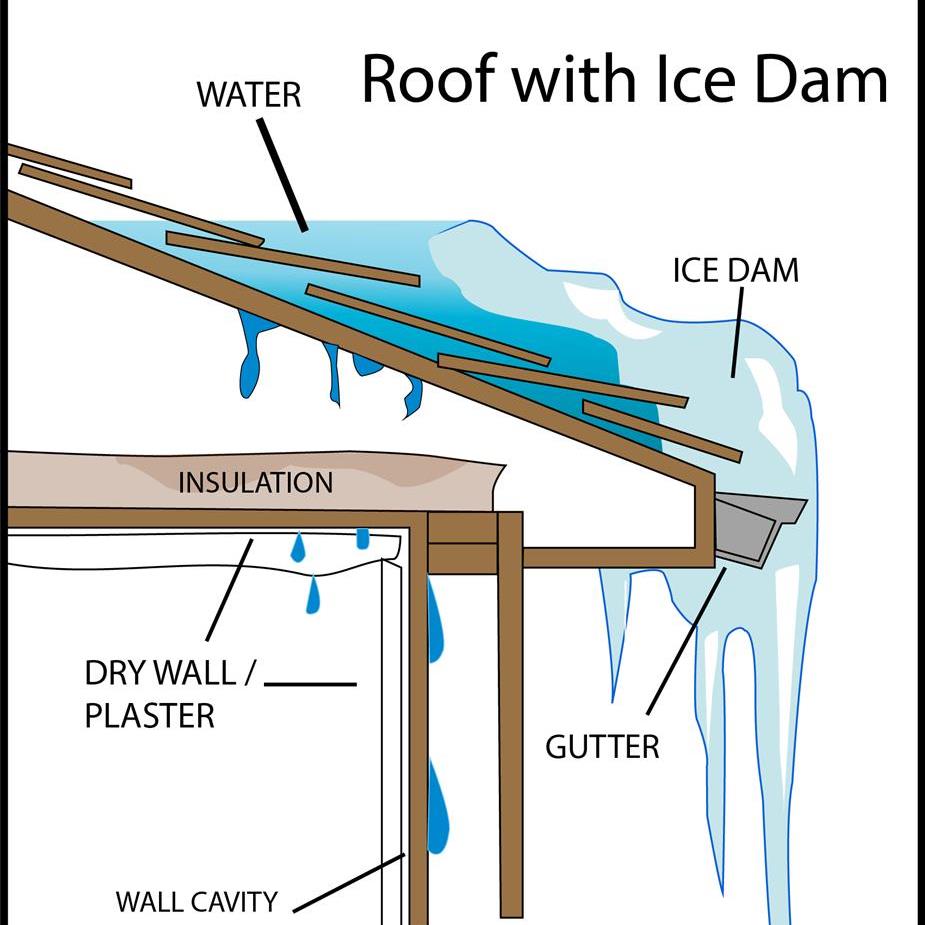 Ice Damming
Ice Damming
When looking at roofs this winter, icicles hanging along them may look beautiful but can be very dangerous. This is because the icicles forming and snow on the roof can lead to ice dams. These are thick ridges of solid ice that build up along the eaves. Dams can tear off gutters, loosen shingles, and cause water to back up and pour into the building or home. In result, this can lead to peeling paint, warped floors, stained and sagging ceilings. Also, soggy insulation in the attic, which loses R-value and becomes a magnet for mold and mildew.
Here are some ways in order to prevent ice dams. The first is to use heated cables. Attach these with clips along the roof's edge in a zigzag pattern, and the heated cables help prevent ice dams that lift shingles and cause leaks. This solution allows you to equalize your roof's temperature by heating it from the outside instead of blowing in cold air from the inside.
Next is to blow in cold air. Hacking away at ice dams with a hammer, chisel, or shovel is BAD for your roof. Also, throwing salt on them will do more harm to your plantings than the ice. Therefore, take a box fan into the attic and aim it at the underside of the roof where water is actively leaking in. This targeted dose of cold air will freeze the water in its tracks.
You can also rake it by pulling off snow with a long-handled aluminum roof rake while you stand safely on the ground. A rake with wheels will instantly change the exterior temperature of your roof without damaging shingles.
De-icing methods deal with diminishing the damage after the dam has formed. Fill the leg of a discarded pair of panty hose with a calcium chloride ice melter. Lay the hose onto the roof so it crosses the ice dam and overhangs the gutter. You can use a long-handled garden rake or hoe to push it into position. The calcium chloride will eventually melt through the snow and ice and create a channel for water to flow down into the gutters or off the roof.
Lastly is a permanent fix for ice dams. Getting ride of ice dams for good is simple. Just keep the entire roof the same temperature as the eaves. This is done by increasing the ventilation, adding insulation, and sealing off every possible air leak that might warm the underside of the roof.
1. Ventilate Eaves and Ridge
- A ridge vent paired with continuous soffit vents circulates cold air under the entire roof. Both ridge and soffit vents should have the same size openings and proved at least 1 square foot of opening for every 300 square feet of attic floor. Place baffles at the eaves to maintain a clear path for the airflow from the soffit vents.
2. Cap the Hatch
- An unsealed attic hatch or whole-house fan is a massive opening for heat to escape. Cover them with weather stripped caps made from foil-faced foam board held together aluminum tape.
3. Exhaust to the outside
- Make sure that the ducts connected to the kitchen, bathroom, and dryer vents all lead outdoors through either the roof or walls, but never the soffit.
4. Add insulation
- More insulation on the attic floor keeps the heat where it belongs. To find how much insulation your attic needs, check with your local building department.
5. Install sealed can lights
- Old-style recessed lights give off great plumes of heat and can't be insulated without creating a fire hazard. Replace them with sealed "IC" fixtures, which can be covered with insulation.
6. Flash around chimneys
- Bridge the gap between chimney and house framing with L-shaped steel flashing held in place with unbroken beads of a fire-stop sealant. Using canned spray foam or insulation isn't fire safe.
7. Seal and insulate ducts
- Spread fiber-reinforced mastic on the joints of HVAC ducts and exhaust ducts. Cover them entirely with R-5 and R-6 foil-faced fiberglass.
8. Caulk penetrations
- Seal around electrical cables and vent pipes with a fire-stop sealant. Also, look for any spots where light shines up from below or the insulation is stained black by the dirt from passing air.
Understanding the lifecycle of ice damming is key. It starts with the birth, and it is the breakdown of the conditions that lead to the formation of ice dams. First, heat collects in the attic and warms the roof, except at the eaves. Next you move into the growth, and snow begins to melt on the warm roof and then freezes on the cold eaves. Finally is maturity, and ice accumulates along the eaves, forming a dam. Meltwater from the warm roof backs up behind it, flows under the shingles, and into the house.
How long does it take for water to damage a house?
12/1/2020 (Permalink)
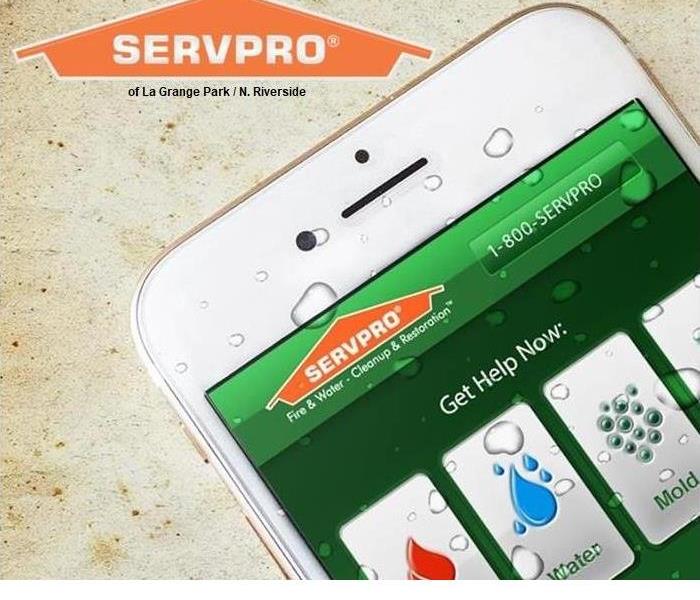 GET THE APP!
GET THE APP!
Within Minutes
- Water quickly spreads throughout your property, saturating everything in its path.
- Water is absorbed into walls, floors, upholstery, and belongings.
- Furniture finishes may bleed, causing permanent staining on carpets.
- Photographs, books, and other paper goods start to swell and warp.
Hours 1 - 24:
- Drywall begins to swell and break down.
- Metal surfaces begin to tarnish.
- Furniture begins to swell and crack.
- Dyes and inks from cloth and paper goods spread and stain.
- A musty odor appears.
48 Hours to 1 Week:
- Mold and mildew may grow and spread.
- Doors, windows, and studs swell and warp.
- Metal begins to rust and corrode.
- Furniture warps and shows signs of mold.
- Paint begins to blister.
- Wood flooring swells and warps.
- Serious biohazard contamination is possible.
More Than 1 Week:
- Restoration time and cost increase dramatically; replacing contaminated materials and structural rebuilding may be extensive.
- Structural safety, mold growth, and biohazard contaminants pose serious risks to occupants.
How Much Does Water Damage Restoration Cost?
9/1/2020 (Permalink)
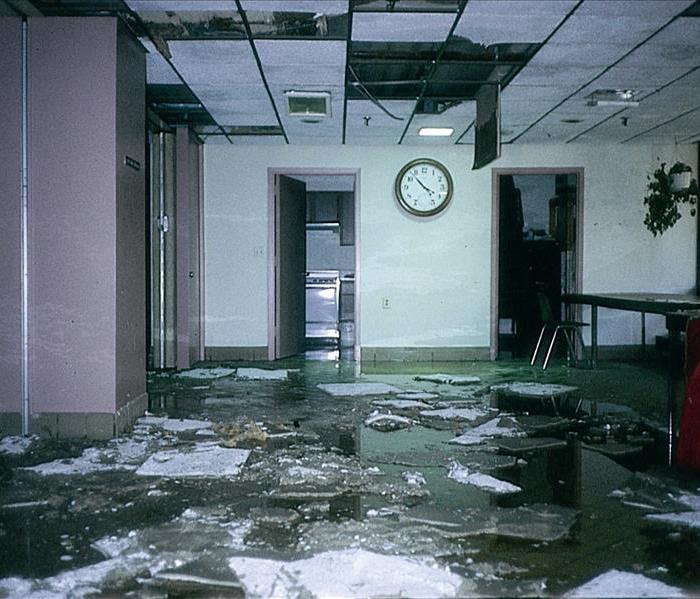 Call SERVPRO when water damage affects your business!
Call SERVPRO when water damage affects your business!
When it comes to owning a business or a home, water damage can be one of the most costly things there is. You can not only lose out on days or weeks of productivity, but you could also find yourself repairing or replacing valuable equipment like electronics, tools and inventory. This is where the costs come into play.
- On average, water damage from a sink will run $7,000.00 for each instance
- For toilets, that number ranges between $2,000.00 and $10,000.00
As we can see, this can add up very fast! Here are some causes of water damages, and what you can do to help prevent them.
1. Appliances and Equipment
- Air conditioners, water heaters or anything that uses tubes, pipes, gaskets or filters to operate has the potential to leak. The best thing to do is to regularly look over and maintain your equipment. If you notice anything that concerns you, such as rust, cracks, bulges or signs of moisture, call SERVPRO.
2. Roofing
- Make sure you're checking your roof regularly. If you've got a pond up there, your drainage isn't working effectively. Keep in mind that every inch of water weighs in at around 5 lbs. Be sure to look for any damage to your perimeter flashing, roof membrane or roof penetrations like drains, pipes and gas lines.
3. Pipes and Drains
- Your plumbing system is susceptible to stoppages, clogs and damage. If a crack develops, it could dumb 250 gallons of water per day on your facility. Look for outward signs of moisture, blue stains, rusting, and cracking and bulging. If you're having plumbing work done or you have a cut pipe for any reason, check for scale buildup. You can also try a pipe camera to get a good look at what's going on inside your system.
4. Sprinkler Systems
- Many commercial buildings are outfitted with sprinkler systems, which are great for minimizing fire damage, but not so great for water damage when they malfunction. Always check your sprinkler system for signs of damage or rust, and replace them regularly to make sure they are functioning properly.
5. Mother Nature
- Natural disasters like hurricanes, severe thunderstorms ad flash flooding can do untold damage to your business. You can control how ready you are for it though. Keeping your gutters clear, installing barriers and storing sensitive files and electronics at a higher level are all things you can do to keep the damage minimal. Consult with a SERVPRO professional to get your ERP set up and ready in case something like this were to happen.
Key takeaways for preventing water damage
7/23/2020 (Permalink)
Water damage is the No. 1 culprit that weakens your home's foundation and the very core that holds your house together. I am sure you have heard about core strength for your body. Well, water damage hits at the core strength of your home, eventually causing serious structural damage. Damp wood invites termites and carpenter ants. It can also cause mold and mildew if not taken care of properly.
Here is how to prevent water damage using three easy strategies that will give you peace of mind the next time heavy storms hit.
1. Ensure good drainage
- clean your gutters
- direct downspouts 5-10' away from the house
- slope your yard away from the foundation
2. Test your sump pump
- check your sump pump once a year
- test more frequently during storm season
3. Fix water leaks
- repair any noticeable dripping pipes
- check for dark spots under pipes & on ceilings
- repair any cracked caulking
- inspect the roof for missing, loose of damaged shingles
By following these tips, you are going to have less of chance when it comes to the amount of water damage that the home may take on.
How To Save Materials in Your Home After a Flood
2/11/2020 (Permalink)
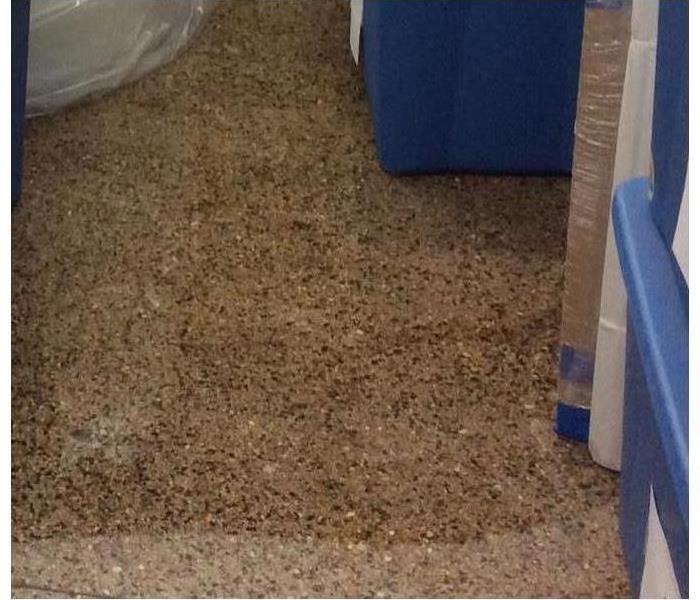 Water pipe break in Westchester, IL
Water pipe break in Westchester, IL
You do your best to safeguard your family, property, and possessions from harm and accident. Unfortunately, disasters in your home can occur and cause widespread damage. When you discover water in home, you can feel devastated by the potential loss of important items and materials. With the prompt help of a professional flood remediation company, it's possible to salvage even the most delicate possessions. There are things you can do to mitigate problems after a flood, but you can trust the pros to make your home whole again.
The Process the Professionals Use
As soon as you can, get in touch with a water removal company. Most crews can arrive at your home within a few hours of your call, regardless of the time or the day when you call. Once on the scene, the technicians will do the following:
- Evaluate what caused water in home.
- Assess the extent of the damage.
- Remove all water.
- Thoroughly dry the area.
- Disinfect the affected area.
- Restore and rebuild as needed.
Floor Cleaning
Hardwood floors and carpets often bear the brunt of flooding. Using dry cleaning, crews can often salvage these materials. Technicians will first tear out the carpet or wood and set them out to dry. Crews will remove all saturated water and will dry the items to avoid the growth of mold.
Document Cleaning
You've probably got books, photographs and documents in your Westchester, IL, house that you can't afford to lose. The pros will treat each item delicately, laying them out to dry. Next, a technician will use freeze-drying to remove all water. Once the paper is dry, it won't crinkle or curl.
Electronics Cleaning
Never turn on an electronic after a broken pipe or other problems caused a flood. Professional technicians will carefully get rid of any water and dry the product. Crew members have the right equipment and tools to safely do the job.
Don't let water in home spell doom for you. Professional teams have what it takes to restore your materials and belongings.
Three Common Water Issues Your Commercial Building Might Experience
1/31/2020 (Permalink)
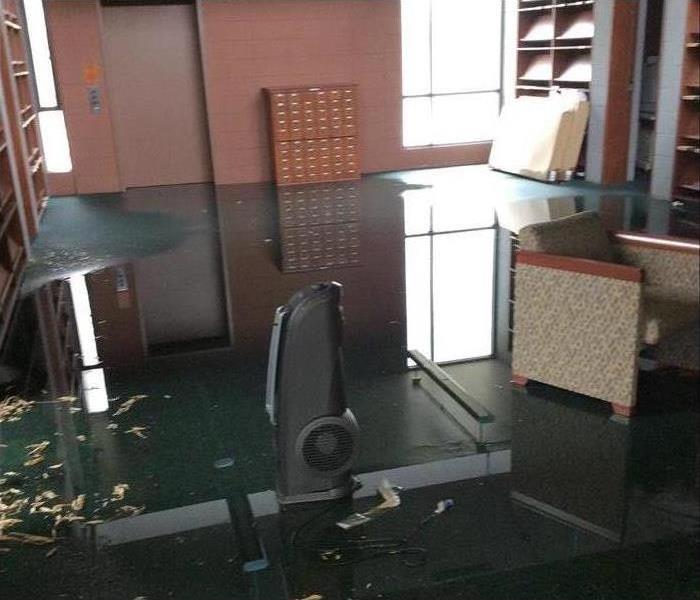 Commercial water loss in Maywood, IL
Commercial water loss in Maywood, IL
3 Common Water Problems You May Find in Your Commercial Building
No matter what kind of commercial building you have in Maywood, IL, it is important to keep it in top condition. Water damage is a common problem that can occur, and it can stem from leaking pipes or something larger. The following are a few issues that you should look out for.
1. Backed Up Plumbing
Sometimes, a sink or toilet backup may not be a big deal, but if it is happening often, then there could be a larger problem. Plumbing can become backed up when the water is not able to drain as it should. While this may be a simple clog that can be quickly taken care of, it can also indicate problems in your pipes. Sometimes this happens if certain materials are disposed of improperly. To prevent this, only flush paper products that are designed to dissolve quickly and avoid pouring food or grease down your drains.
2. Broken Pipes
While your plumbing system is designed to last for a long time, it will not last forever. Depending on the materials from which they are made, some pipes will need to be replaced every few decades while others may last much longer. Whatever kind of pipes your building uses, it is a good idea to perform inspections and maintenance regularly to find and repair any damage before a pipe break occurs.
3. Leaking Pipes
Leaks may not seem like as much of a problem as breaks, but they can cause quite a bit of damage over time. Excessive amounts of moisture can cause mold to grow in your building and can weaken some materials. Along with causing physical issues, leaks can also result in higher water bills, so it is best to have them fixed as soon as possible.
If any of these common problems have resulted in damage to your building, a water damage remediation company can perform cleanup and repairs. They can fix leaking pipes and other sources of moisture, remove excess water from the area, and restore your building.
Important Clean-up Steps After a Flood
12/6/2019 (Permalink)
Important Clean-up Steps After a Flood
If you discover water in home, it's important to respond quickly to mitigate the damage. With the right help, you can salvage many of the items in your Riverside, IL, house. There are steps you can take to minimize problems, but you should also contact a professional to handle the more significant damage.
Immediate Aftermath
Your first job once you discover flooding in your home is to try to stop the source, if it's safe to do so. You should also contact your insurance company to file a claim and get a hold of a professional flood remediation team to assess the extent of the damage. In the meantime, you can do the following:
- Unplug all electronics.
- Remove items out of the water or away from the wet areas.
- Lay clothes, documents or other materials out to dry.
Cleaning Carpets and Furniture
A professional water cleanup company may be able to salvage wet carpet and furniture. The team will use a thorough dry cleaning process to extract water from the floor and from sofas or chairs. It is also important to dry out the materials to discourage the growth of mold. Crews will use high-powered fans and dehumidifiers to accomplish this. Lastly, a technician will sanitize the area to kill any fungal growth.
Cleaning Documents
Whether it's a broken pipe or a massive storm that brings water inside your house, paper can suffer damage from the flood. Specialists can use freeze-drying methods to save items such as books, photographs, maps and documents.
Cleaning Electronics
It's no secret that moisture and products such as computers, televisions and stereos don't mix. When you have water in home, electronics can suffer. Luckily, the professionals have effective methods to carefully treat the items. The team will start by drying the outside and then will move to the interior of the electronics. You shouldn't try to handle wet electronics by yourself.
For water in home, make sure you get a professional water removal company on the job. You can rest assured knowing you can still use many of your belongings.
How To Deal With Water Damage in 5 Steps
10/18/2019 (Permalink)
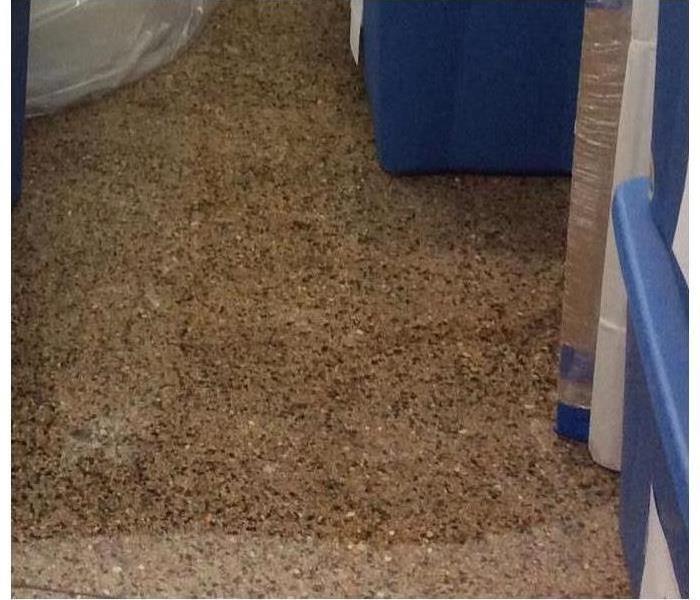 Water damage in a Forest Park, IL storage area
Water damage in a Forest Park, IL storage area
How To Deal With Water Damage in 5 Steps
Water incidents can devastate your home in Forest Park, IL, if they are not dealt with immediately. They can leave behind massive water damage, which not only ruins the residence's look but also endangers its stability. Reduce damage to your home by taking the following steps after such an incident.
1. Check for Safety
Before dealing with the damage, you should ensure you and everyone else in the area is safe. A flooded area can have electrical hazards, toxic chemicals or other dangers enhanced by water. Disconnect all power before approaching.
2. Find and Stop the Source
If the area is safe, determine the water source and stop the flow, if possible. These incidents are sometimes caused by natural flooding or an outside leak. Find the entrance and seal it. Other times, these incidents occur due to damaged or broken pipes. Stop the leakage if you can or turn off the water supply to the pipes or house.
3. Call for Assistance
Water damage is something you cannot solve by yourself, so be prepared to contact the necessary services. First, call 911 if you or someone else is injured or if there is a dangerous situation. Then, contact a professional water cleanup company to deal with both excess water and the damage done to the home. Finally, call the insurance company.
4. Clear Excess Water
While you may not be able to deal with the water incident entirely, you can still take steps to clear some of the excess water. Depending on the source, you can use a mop or a water vacuum to clear the majority. Air conditioning, a fan or an open window can also dry out the area effectively. If it is too dangerous, wait for the cleanup professionals.
5. Assess the Damage
Now that the water has been removed, you can inspect the severity and size of the damage. Take note of details, as this information can be helpful for the insurance and cleanup companies.
Water damage can leave lasting consequences. Through quick action, you can prevent a disaster from permanently impacting your home.
Tips for Preventing Water Damage While on Vacation
8/27/2019 (Permalink)
 Check your water heater for leaks
Check your water heater for leaks
When you go on vacation, you want to be able to relax knowing that your home in Berwyn, IL, is safe and sound. One of the biggest worries a homeowner can face is that of water damage and water pipe repair. Luckily, there are certain steps you can take to prevent this from happening while you're away.
Inspect Everything
First, you will want to make a thorough sweep of your home, in order to make sure nothing is leaking and everything is sealed up tight. Some commonly problematic areas to include in your inspection are:
- clear the debris from the sump pump
- check your water heater for leaks
- make sure there isn't a leaking or broken pipe under any of your sinks
- see that the hoses that connect to major appliances are in good shape
Prepare Your Home
Next, you might want to take certain measures to prepare various protection systems in your house. You can clean out your gutters. Reseal any windows or repair your roof if necessary. If you found a leak, do some water pipe repair before you go. If you are taking a vacation in the winter, insulate your pipes and leave the cupboards open so they don't freeze. Finally, remember to turn off your water, and flush the toilets after you do so to drain them of water.
Keep an Eye On It
If possible, have someone visit your home periodically throughout your absence to make sure it's not flooded. You can ask a friend or you could hire someone. Another option is to install a leak detection system. They will set off an alarm and can notify your phone. It's also a good idea to have a licensed water damage restoration specialist picked out, in case you do need to address a situation right away from afar.
The last thing you want to do when taking a much needed vacation is rush home to complete a water pipe repair. If you leave your home in top condition and make sure it is looked after, you won't ever have to!
3 Ways To Prevent Water Damage
6/11/2019 (Permalink)
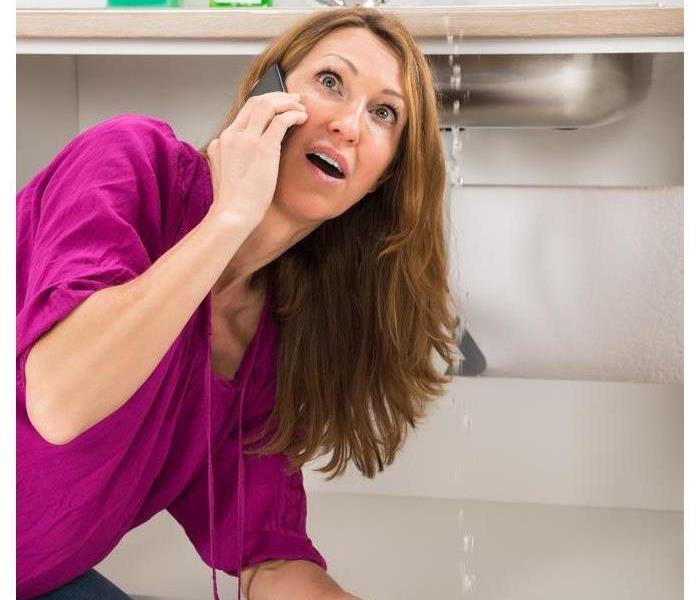 If there is a leak in your home, you should have it repaired as soon as possible
If there is a leak in your home, you should have it repaired as soon as possible
Protect Your House from Harm
There are many things that can cause water damage to your La Grange, IL, home, from accidents to natural disasters. Luckily, there are also several steps you can take to prevent it. In many cases, using the following tips will allow you to protect your house from harm.
1. Perform Regular Maintenance
While it can sometimes seem bothersome, you should perform maintenance on your home on a regular basis to avoid preventable water damage. This should include inspecting each area of your property and checking your plumbing and appliances for signs of disrepair. Examine the exterior as well to locate any cracks. Maintaining your home can limit future issues and make an insurance claim go more smoothly if a problem occurs.
2. Repair Leaks Right Away
Many people ignore small leaks and assume that they are not a big deal. However, this is not always the case. If there is a leak in your home, even if it does not seem severe, you should have it repaired as soon as possible. These can lead to large areas of damage as well as broken pipes if they are ignored.
3. Prepare Your Home for Storms and Cold Weather
Sometimes the water damage will come from outside the house rather than inside. If you are expecting a severe storm, be sure to prepare your home beforehand. Clean your drains and gutters to prevent roof leaks caused by backed up water, and make sure that all doors and windows are properly sealed. During the colder months of the year, keep the inside sufficiently heated and consider insulating your pipes to stop them from freezing and bursting.
While you can prevent certain problems, some accidents are unavoidable. If your home is impacted by water, you can call an emergency restoration service to repair the damage. They can perform remediation, water cleanup and any necessary repairs to your property.
Water Damage repair process
5/27/2019 (Permalink)
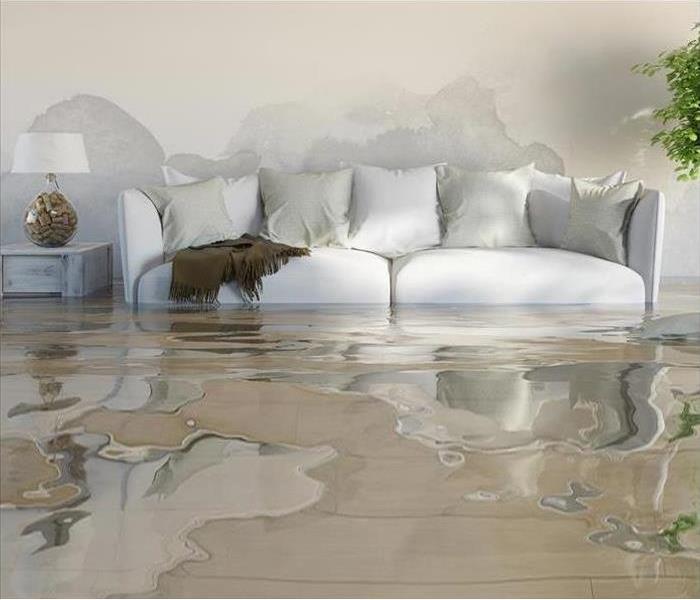 SERVPRO of La Grange Park/ North Riverside provides a 24 hour fire and water damage restoration service.
SERVPRO of La Grange Park/ North Riverside provides a 24 hour fire and water damage restoration service.
Flooding and water damage is very invasive. Water quickly spreads throughout your home and gets absorbed into floors, walls, furniture, and more. SERVPRO of LaGrange Park/North Riverside arrives quickly and starts the water extraction process almost immediately. This immediate response helps to minimize the damage and the cleaning and restoration costs.
Need Emergency Service? Call Us 24/7 – 708-240-4873.
Water Damage Timeline
Within Minutes
- Water quickly spreads throughout your property, saturating everything in its path.
- Water is absorbed into walls, floors, upholstery, and belongings.
- Furniture finishes may bleed, causing permanent staining on carpets.
- Photographs, books, and other paper goods start to swell and warp.
Hours 1 - 24:
- Drywall begins to swell and break down.
- Metal surfaces begin to tarnish.
- Furniture begins to swell and crack.
- Dyes and inks from cloth and paper goods spread and stain.
- A musty odor appears.
48 Hours to 1 Week:
- Mold and mildew may grow and spread.
- Doors, windows, and studs swell and warp.
- Metal begins to rust and corrode.
- Furniture warps and shows signs of mold.
- Paint begins to blister.
- Wood flooring swells and warps.
- Serious biohazard contamination is possible.
More Than 1 Week:
- Restoration time and cost increase dramatically; replacing contaminated materials and structural rebuilding may be extensive.
- Structural safety, mold growth, and biohazard contaminants pose serious risks to occupants.
About SERVPRO of LaGrange Park/North Riverside
SERVPRO of LaGrange Park/North Riverside specializes in the cleanup and restoration of residential and commercial property after a fire, smoke or water damage event. Our staff is highly trained in property damage restoration. From initial and ongoing training at SERVPRO’s corporate training facility to regular IICRC-industry certification, rest assured our staff is equipped with the knowledge to restore your property.
Flooding and water emergencies don’t wait for regular business hours and neither do we. SERVPRO of LaGrange Park/North Riverside provides emergency cleaning and restoration services 24 hours a day, 7 days a week—including all holidays.
Common Plumbing Issues in Commercial Buildings
4/18/2019 (Permalink)
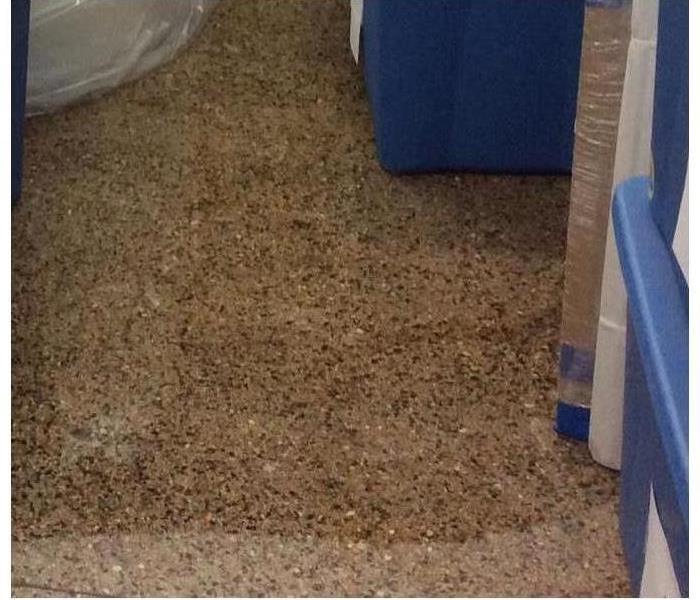 Only by performing proper inspections and maintenance can a property owner reduce risk and minimize potential issues.
Only by performing proper inspections and maintenance can a property owner reduce risk and minimize potential issues.
Commercial buildings are often plagued with plumbing issues, such as a blocked sewer. The reason behind these common detriments is the continual usage of the overall system. As a commercial business owner or manager, you are likely aware that your facility is used more frequently than a residential property might be. This added strain creates many common issues for a variety of commercial buildings.
1. Cast Iron Deterioration
While you may have gone to extensive lengths to ensure that all the plumbing in your facility was replaced or in good standing, did you remember to inspect the lines connecting your property to the municipal lines? These connections and pipes are often made of cast iron, which can deteriorate over time. Common signs of this issue are toilet overflow and sewage backup.
2. Sewer Backup
Again, because of the increased usage of your building’s facilities, a blocked sewer is more likely to occur. While this may be symptomatic of deteriorating pipes, it may be simpler than that. It is possible that the blockage is the result of a clog of sanitary and personal products.
3. Copper Pipe Breaks and Leaks
Another common issue is found in copper piping. These pipes have a propensity to develop pinhole leaks or even pipe breaks. While some of these breaks are not a result of neglect, many can be prevented with proper maintenance and inspection.
4. Foundation and Structural Issues
If you have an unknown leak, you may notice some foundation and structural issues. For instance, leaks can lead to wall and ceiling cracks or a loss of structural integrity. A plumbing specialist in the Riverside, IL area can assess your property to help you pinpoint possible solutions and develop maintenance routines.
While a blocked sewer is one common problem shared by most commercial properties, there are many others. Only by performing proper inspections and maintenance can a property owner reduce risk and minimize potential issues.
Responding to a Home Flood Disaster
3/18/2019 (Permalink)
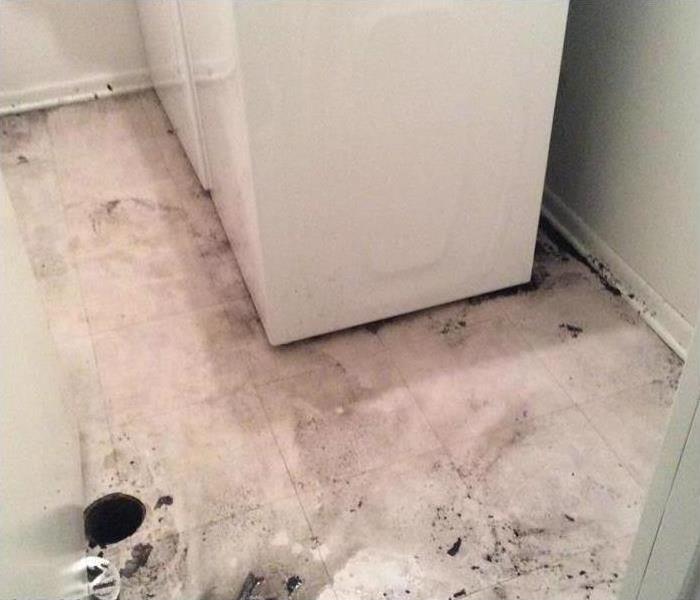 If you experience a flood due to a broken pipe or other water event, it's important to act quickly and safely.
If you experience a flood due to a broken pipe or other water event, it's important to act quickly and safely.
Responding To A Home Flood Disaster
A flood can be one of the most devastating things to happen to your home and life. It can come from heavy rain, a broken pipe, defective appliances, sewage backup, and other unexpected causes. Because flooding is generally kept off your radar until it actually happens, you may find yourself overwhelmed with questions about how to act in the best interest of your safety and belongings. Here are three tips for responding to a home flood.
1. Identify the Damage
Is the source of the water a broken pipe or something more complicated? Is it clean water or contaminated? These kind of questions will help you decide how to proceed. If it's Category 2 or Category 3 contaminated water, it could be hazardous to enter the area without proper protective gear. Do not enter the wet area unless it is clear what kind of damage you have experienced.
2. Turn Off Power
Your next move should be to shut off the main power to your home in order to avoid electrocution in the initial cleanup stages. If this task will have you wading through the flooded area, do not proceed with the list and simply evacuate the home.
3. Call a Professional
Although there are minor things you can do while waiting for emergency restoration services to arrive, it is not wise to take on remediation without the proper training and experience. There are a mountain of risks that could end up worsening the damage if you’re not careful. Even simply waiting too long to begin cleanup poses a danger to your home and health, so it is best to act as soon as the water in your home is detected. Do not attempt to fix a damaged pipe or appliance on your own, either; always consult an expert in La Grange, IL for advice on your specific situation.
If you experience a flood due to a broken pipe or other water event, it's important to act quickly and safely. Sometimes the safest, smartest thing to do is leave cleanup to the professionals.
Mitigation terms and definitions
3/4/2019 (Permalink)
Education is always a plus when you are not in that industry or have questions. Giving you terms and definitions will help you to understand a little of what your mitigation company SERVPRO is talking about when they are scoping the job for the techs to perform the work. Just like watching subtitled moves to learn another language, just a little easier.
Condensation – The process of changing water from a vapor to a liquid.
Contracts – Water damage services should not begin until an adequately contract is signed by the property owner. Contracts should specify the party responsible for payment.
Conventional refrigerant dehumidifier – This kind of dehumidifier loses efficiency as the air dries below 55 grains per pound. It removes water vapor from the air using a process called condensation.
Dehumidifier/dehumidification – If electric cords become frayed, the device should be removed from service and the cord repaired properly. Mechanical dehumidification should be used when the outdoor humidity ratio is higher than the humidity ratio indoors. Dehumidification is the process of removing water vapor from the air.
Desiccant dehumidifier – This kind of dehumidifier creates the lowest humidity ratio, which means that it also creates the lowest vapor pressure.
Dew point temperature – The temperature at which the air becomes saturated, 100% relative humidity. Air that contains the maximum water vapor at a given temperature is saturated.
Drying goals – Drying is not complete until all affected materials have been returned to their pre-determined drying goals.
Drywall (Gypsum board) – Ceilings that are saturated and sagging should be drained, removed quickly, and discarded. Drywall becomes more fragile when wet and more stable as it dries.
EPA registered products – When using these products, you must follow label directions. The use of antimicrobials on water projects may or may not be advisable. Technicians should obtain the customer’s informed consent before applying antimicrobials on a water project.
Evaporation – The process of changing water from a liquid to a vapor. As water evaporates from a material the temperature of the surface of the material gets cooler; this is known as evaporative cooling.
Hardwood flooring – Technicians should dry hardwood flooring until it reaches within 2-4 percentage points of normal EMC. After the floor has been dried to acceptable moisture content, appropriate acclimation time should be allowed before refinishing. If drying wood floors is feasible, it is recommended that you attempt to achieve a target humidity ratio of less than 40 grains per pound as quickly as possible. When moisture causes the wood flooring to swell across the width of each plank, with the edges higher than the center, the planks are cupped.
High-risk persons – People who are very young, very old, have suppressed or compromised immune systems, have allergies, or have respiratory problems. If high-risk persons are present on a water project, restorers should recommend third-party evaluation by an Indoor Environmental Professional (IEP). High-risk persons who are present on a Category 3 water loss should remain off the work site until the building is safe to re-occupy.
Humidity ratio – The amount of water vapor that a volume of air contains by weight. Humidity ratio is directly related to vapor pressure.
Hygroscopic materials – Hygroscopic materials continue to absorb water until they reach equilibrium. They can have secondary damage from high humidity. The potential for damage to hygroscopic materials is greatest when the relative humidity is above 60%.
Low-grain refrigerant dehumidifier – This kind of dehumidifier removes water vapor from the air using a process called condensation. LGR dehumidifiers continue to remove a significant amount of water vapor below 40 grains per pound.
Moisture content – The measurement of the amount of moisture contained in a material, expressed as a percentage of the weight of the oven-dry material. If a restorer is measuring materials with an instrument that is calibrated for that material, then it is recommended that the term moisture content be used.
Moisture level – The measurement of the amount of moisture contained in a material on a relative scale. If a restorer is measuring materials with an instrument that is not calibrated for that material, then it is recommended that the term moisture level be used.
Mold – Use appropriate protective measures when mold growth is discovered.
Monitoring – Water projects should be monitored at least once every day. Daily readings should include all applicable air, equipment, and HVAC output readings.
Open drying system – This method uses outside air to reduce the indoor humidity. When deciding if an open drying system is appropriate, restorers should consider the humidity ratio of the indoor air as compared to the humidity ratio of the outdoor air and occupant comfort.
Permeance – Permeance is the ability of water vapor to pass through a material.
Refrigerant dehumidifier – This kind of dehumidifier is the most energy-efficient type of dehumidifier. It continues to perform efficiently down to 70°F. It is usually the most efficient dehumidifier to use in warm, wet environments. Dehumidifier capacity is reported in pints per day (ppd); this reported amount of water removal is based on an AHAM test at 80°F and 60% RH for 24 hours.
Relative humidity – The ratio of moisture suspended in the air expressed as a percentage of the total moisture-holding capacity of the air.
Safety issues – One of the technician’s first responsibilities on a water project is to identify and communicate safety hazards. The most common safety issue on water projects is slippery floors.
Sanitizer – A product designed to significantly reduce, but not eliminate, microorganisms of public health importance.
Sterilizer – An antimicrobial designed to kill all forms of viruses, bacteria, and fungi, including their spores.
Sublimation – The process of changing water from a solid to a vapor without going through the liquid phase.
Vapor pressure – Vapor pressure is the force exerted by a gas on its surrounding environment.
Waste water disposal – The best place to dispose of all waste water is back into the sanitary sewer system. When a sanitary sewer system is not available, waste water should be disposed of at an approved municipal waste water disposal site.
Ice Daming
11/27/2018 (Permalink)
 IF YOU SEE ICICLES YOU HAVE AND ISSUE!
IF YOU SEE ICICLES YOU HAVE AND ISSUE!
Ice dams occur after a heavy snowfall when warm air in the attic causes the roof to warm and the snow to melt. Water running down the roof refreezes when it reaches the colder roof edge, forming a mound of ice.
Icicles are a sure sign of poor roof ventilation and poor insulation in your home. Warm moist air from inside your home can move upwards and leak around ceiling lights through poorly insulated ceilings and around attic access openings.
Temp fix for the issue:
Lay the hose onto the roof so it crosses the ice dam and overhangs the gutter. If necessary, use a long-handled garden rake or hoe to push it into position. The calcium chloride will eventually melt through the snow and ice and create a channel for water to flow down into the gutters or off the roof.
Garden Hoses Can Cause Water Damage To Your Home
7/27/2018 (Permalink)
A 25-foot, 1/2-inch diameter hose attached to a faucet that supplies water at 40 psi has a flow rate of 24 gallons per minute, while a 100-foot hose only has a flow rate of 6 gallons per minute. That is a lot of water coming from a garden hose. That is why it is so important to make sure that when you are out watering your garden or flowers that you keep an eye on the hose. Walking away from your hose while it is on can cause water to flow into your home and cause water damage.
A leaking garden hose can also cause water damage to your home as well as mold damage due to the long period of time that the water might be entering your home. Here are some things you should look for when you come across a leaking water hose, and how you can stop the water from entering your home.
The most important thing to determine is where the leak on your hose is actually coming from. This shouldn’t be too difficult to do, but depending on the location will determine the severity of the problem and how much effort it will take to fix it. If your hose always leaks from around the connection to the water tap, you may have either a problem with the spigot itself, or the hose fitting. If water wells up around the handle, your packing washer may be worn out, or the packing nut may need to be tightened, but if water only leaks when your hose is secured to the faucet, then you need to see if the water is welling up around the actual connection, or from below the fitting.
If you find that you have water damage to your home due to water entering your home from the garden hose, SERVPRO of LaGrange Park/North Riverside is here to help. Give us a call at 708-240-4873.
Two Easy Ways to Avoid Water Damage
6/27/2018 (Permalink)
Water damage is the No. 1 culprit that weakens your home’s foundation and the very core that holds your house together. You’ve heard about core strength for your body. Well, water damage hits at the core strength of your house, eventually causing serious structural damage. Damp wood invites termites and carpenter ants; plus, it causes mold and mildew.
Here’s how to prevent water damage using three easy strategies that will give you peace of mind the next time heavy storms hit.
#1 Test Your Sump Pump
Sump pumps come to life during storms. That’s not when you want to realize yours isn’t working properly. You should check it at least once a year, and ideally perform several checks during heavy storm seasons.
How to test your sump pump:
- Slowly fill the sump pump pit with water. Watch for the “float” (similar to the float in your toilet) to rise, which should turn on the pump. Then watch to make sure the water level falls.
- Test your backup pump the same way, but unplug the main pump first.
- If you don’t have a backup pump — or a generator — and are on municipal water, get one that runs on water pressure. If you’re on well water, your only option is the battery kind.
#2 Check for water leaks and fix them.
- Check for dark spots under pipes inside sink cabinets, stains on ceilings, toilets that rock, and of course drips.
- At least once a year, inspect your roof. Repair missing, loose, and damaged shingles. Repair any cracked caulking and check for leaks around flashing.
Prolonged and persistent leaks lead to mold.
This is just 2 very simple ways to avoid having water damage to your home. However, life happens and SERVPRO of LaGrange Park/North Riverside is here to help. Give us a call at 708-240-2873 for all your water damage needs.
Water Damage Insurance Claim Tips
6/15/2018 (Permalink)
SERVPRO of LaGrange Park/North understands the insurance companies and how to help guide you through your claim. Here are some claim tips to assist you with your claims process for water damage.
Contact Your Insurance Company ASAP
Keep your policy number at hand and be prepared to provide them with detailed information of damages.
Take Note Of Everything
Keep detailed records of everything during the initial call. This includes the name of the agent you’re speaking to, the date of the call, the time, and what was discussed.
Keeping this information handy will help you if you experience a problem with your claim.
Document the Damage
DON’T throw anything out or try to make permanent repairs before the adjuster is able to estimate the damages. Doing this may void coverage. Take photographic evidence of damages, make a detailed list of damaged items, and provide receipts if you have them available.
Damage Control
You’ll want to (and your insurance company expects you to) do as much as you can to prevent further damages. These are considered emergency repairs and will not affect your coverage.
If your house is flooding or if you’re suffering from storm damage, soak up as much of the water as possible, dry out waterlogged items, and board up broken windows.
Keep receipts for the cost of these emergency repairs, and if you’ve had to relocate, keep receipts for any travel or lodging expenses.
Dealing with water damage is stressful enough, so we try to make the insurance process as stress-free possible. As a courtesy to our customers, we’ll guide them through the insurance process and help them with their insurance claim.
SERVPRO of LaGrange Park/North Riverside is always here to help. Give us a call at 708-240-4873 for all your residential or commercial water damage needs.
5 Ways to Prevent Water Damage To Your Home This Spring
5/16/2018 (Permalink)
Water damage is very common in the spring due to warmer weather, melting snow, and rains that cause flooding. Here are a few ways you can help control the water entering your home.
Check your downspouts and gutters. When debris gets trapped in gutters, it can block the passage of water from flowing freely off of roofs and away from the home. Clearing out debris from both gutters and downspouts can help to prevent water from entering into attics, walls, and foundations.
Mend foundation cracks. Water can get in more easily when there are cracks in the foundation. For minor repairs, fill cracks with a concrete patch. For bigger concerns, it is best to call a professional.
Re-grading the landscaping surrounding your home to make sure water drains away from the home instead of toward it. If necessary, pull plant material and add more soil where needed. The most important part is to keep the water running away from your home.
Installing sump pumps to help send water away from the home in areas such as basements and below-grade rooms that tend to flood more easily. Inspect your sump pump to make sure it is in good working order and is clear of debris.
Installing window well covers not only allows for natural light in below ground rooms but also prevents melting snow and rain from making its way into the home.
SERVPRO of LaGrange Park/North Riverside understands that water happens, and that unfortunately no matter what measures you take to reinforce your home, water can still get in. Give us a call at 708-240-4873 for all your water damage needs.
6 Things that Cause Sump Pump Failures
4/20/2018 (Permalink)
It is spring time in LaGrange Park, and the one thing we know is that rain is never far behind. With the spring rains comes the sump pump failure calls from homeowners. Often we are asked, how does this happen and why does my sump pump fail? The following is some of the top reason we have seen sump pumps fail.
Power failures: When the electricity goes out, and the sump pump does not have a battery backup or the battery backup is not fully charged there is no way for the pump to do their job. Making sure that your battery backup system is fully charged before a storm the best way to ensure you don’t have water backing up into your home.
Wrong size sump pump: When you have an undersized pump it causes the pump to have to work extra hard to remove the water from your home. If the pump is too big, it has to work harder, and in return the life span is lessened.
Defective sump pump: Yes, it does happen that at the time of install the sump pump is defective. It is wise to test the pump when it is initially installed to make sure the pump operates properly.
Frozen of Clogged Lines: If the water cannot exit, the pump does not work. Protecting the water’s exit point of the discharge pipe will keep debris and animals out of the system, making it optimal for your sump pump.
Switch Problems: The switch is the main mechanical reason for sump pump failures. This occurs when the pump shifts from its position inside the basin, rendering the float ineffective. Float is responsible for the smooth operation of the on/off switch. Your sump pump relies on both the switch and the float arm mechanisms to operate effectively.
Last, but not least is Lack of Maintenance: Most sump pumps should be ran every 2-3 months per most manufactures instructions. Testing to make sure your sump pump works before rainy season hits is also recommended.
If you have a sump pump failure this spring, SERVPRO of LaGrange Park/North Riverside is here to help. Give us a call at 708-240-4873.
April Showers Bring May Flowers
3/30/2018 (Permalink)
We all know the “April Showers Bring May Flowers” rhyme from our childhood, but those April showers can also bring water damage to your home.
Often we see home owners call about sewer drain back up, and find they have the coverage but have a cap on that coverage. It is very important for a homeowner to know their policy, so they do not find a large out of pocket expense when those spring rains start over flowering their sewer drains.
Another loss that we find in the spring time are related to the gutters. The winds start kicking up debris into the gutters or the gutters were not cleaned in the previous fall before winter struck and now there is water damage in the ceilings of home from full gutters.
Also, with the wind, rain, and hail we find roof damage and damage from tree branches rise in the spring as well. If a strong storm roars through, you may find your siding damaged by hail and shingles that the wind ripped off the roof. When wind blows shingles from your roof, it makes your home vulnerable to rain, creating the need for emergency roof repair, and water mitigation in your home as well. Make sure that you are taking care of droopy tree branches, and checking the shingles on your roof to see what sort of damage may have occurred during the winter.
Water damage is never fun to deal with as a homeowner. If you experience damage from those spring showers, remember SERVPRO of LaGrange Park/North Riverside is always here to help. Give us a call at 708-240-4873.
Experts Water Damage Restoration Technician Training
2/28/2018 (Permalink)

SERVPRO of LaGrange Park/North Riverside is investing in the future of our technicians by sending them to class to learn the basics of water damage restoration. “The IICRC-accredited Water Damage Restoration Technician (WRT) course is designed to provide basic education for technicians and other materially interested parties in the science and practice of water damage restoration. This course will cover extraction, basic containment and basic mold procedures. This course is designed to teach non-restoration personnel that perform remediation work to give them a better concept of water damage, its effects and techniques for drying of structures. This course will give residential and commercial maintenance personnel the background to understand the procedures necessary to deal with water losses, sewer backflows and contamination such as mold.” (IICRC website) We believe continuing education for not only our technicians, but our office staff provides a better service to our customers. Understanding what SERVPRO does, will make our customers experience with our staff a better experience and allow the customers a feeling they are well taken care of from the first call to our office all the way through the completion of their job.
If you have water damage to your home, or commercial property, give SERVPRO of LaGrange Park/North Riverside a call at 708-240-4873, and let us help you make it "Like it never even happened.”
Which pipes are likely to freeze?
1/3/2018 (Permalink)
Cold temperatures can cause pipes to freeze. Frozen pipes are a problem because they prevent water flow, but even worse, frozen pipes can eventually burst, causing damage and potential flooding.
How do you spot frozen pipes? The first way to spot frozen pipes is frost on the pipes. This can serve as a warning sign that the pipe is frozen before you ever try to turn on the faucet. Examining the pipes under your kitchen sink and noticing frost is a sure sign that you have frozen pipes.
Another way to spot frozen pipes is that the water is not coming out of the faucet, or coming in a very small stream. When you turn on the faucet, and a slight trickle of water or no water at all comes out, the water pipe leading to the faucet may be frozen.
If you have water damage after noticing the frozen pipes give SERVPRO of LaGrange Park/North Riverside a call and we will be happy to help assist with the water damage to your home. Leaving damaged water pipes can cause more problems in the future, so give us a call to help make it "Like it never even happened."
Winter Water Damage
12/11/2017 (Permalink)
For many in the US, the thought of getting home water damage from a cold snap does not even cross our minds, but the truth is, any home can be susceptible to cold. Here are some tips you will need to be aware of in order to protect your home from expensive water damage.
Ice Dams: Ice dams cause a significant amount of water damage each year to homes. There are essentially two ways in handling ice dams. You can do a temporary installation of heat cables on the overhang of your roof. These cables will heat the roof area and melt the snow not allowing it to form ice damn, however, this method can also cause damage to your shingles and shorten the life time of the shingles.
The most effective long-term solutions are to keep heat out of the attic and to promote ventilation under the roof deck to keep it as cold as possible. A soffit-and-ridge vent system usually requires insulation baffles installed at the lower side of the roof, above the exterior walls. The baffles hold back the insulation by a couple of inches, creating a channel for air to flow past the insulation.
Pipe Breaks: When winter temperatures plummet, water can easily freeze inside the piping, causing them to burst. If you are unaware or not home when this happens, massive amounts of flooding to your home can happen to your home, furniture, and rugs. The best way to avoid broken pipes is to wrap the uninsulated pipes with a blanket or foam.
Melting Snow: Melting snow can impact any home, whether it has a basement, crawlspace, or a slab foundation. If enough snow ends up piling up next to your foundation, it’s going to create a lot of water once it melts. If your lawn is not sloped away from your home, you are very likely to get gallons of water coming in from your foundation.
High Winds Roof Damage: Winter storms often bring very fast moving and strong winds with them. These strong winds are capable of tearing shingles off of your roof. Just a small amount of damaged or missing shingles can end up allowing a lot of water into your attic. When possible a roofing company can come and check your roof, but remember that if there is snow and ice on the roof it is not safe for anyone, including trained professionals to get on the roof.
If you experience water damage to your home this winter, SERVPRO of LaGrange Park/North Riverside here to help. Give us a call at 708-240-4873 for all your water damage needs.
How To Prevent Water Damage From Frozen Pipes
12/4/2017 (Permalink)
Frozen pipes are a sure way to water damage in your home, but how do you prevent frozen pipes in the winter? Our friends at American Family Insurance share some great tips on keeping your pipes from freezing.
The best way to prevent your home’s pipes from freezing is to keep them from being exposed to the cold. Here’s how:
- Cover exposed pipes in crawl spaces or attics with insulation sleeves.
- Re-route pipes to an inside wall.
- Use caulking to seal cracks in the foundation or walls that let cold air in.
- Disconnect garden hoses and turn off the water supply to spigots.
- Keep cabinet doors open below your sinks to allow warm air in.
Other ways you can winterize your home from frozen pipes remove all the hoses from the outside water supply. Once you have drained and stored the hose away, open up the outside valve. This will allow the remaining water to drain and allows the pipe to expand without breaking. You should also consider a pipe sleeve to install over the outside water line to insulate and keep ice from forming.
The American Red Cross gives great ideas on preventative action during cold weather to consider to keep your pipes from freezing as well.
- Keep garage doors closed if there are water supply lines in the garage.
- Open kitchen and bathroom cabinet doors to allow warmer air to circulate around the plumbing. Be sure to move any harmful cleaners and household chemicals up out of the reach of children.
- When the weather is very cold outside, let the cold water drip from the faucet served by exposed pipes. Running water through the pipe - even at a trickle - helps prevent pipes from freezing.
- Keep the thermostat set to the same temperature both during the day and at night. By temporarily suspending the use of lower nighttime temperatures, you may incur a higher heating bill, but you can prevent a much more costly repair job if pipes freeze and burst.
- If you will be going away during cold weather, leave the heat on in your home, set to a temperature no lower than 55° F.
There are many way to keep your home safe from winter pipe breaks. Please feel free to reach out to SERVPRO of LaGrange Park/North Riverside at 708-240-4873 if you need any help with your home.
What is a Sump Pump, & What Do They Do?
6/13/2017 (Permalink)
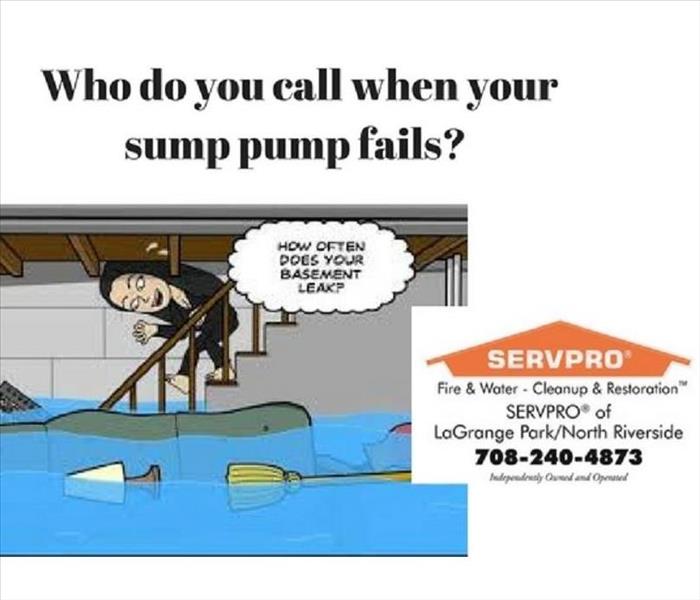 It doesn’t take a huge flood to cause thousands of dollars in damage.
It doesn’t take a huge flood to cause thousands of dollars in damage.
What is a sump pump? A sump pump is a pump used to remove water that has accumulated in a water-collecting sump basin, commonly found in the basement of homes. The majority of residential sump pumps will turn on automatically from a pressure sensor or float activator. The pressure sensor activates as water builds up and creates more pressure than air which prompts the pump to turn on. The float activator has a ball that floats on top of the water, moving the arm as the water level rises. Once the motor activates, the fan will begin to turn moving the water outside the basement.
The American Society of Home Inspectors actually did a study that showed more than 60% of American homes suffer from underground wetness or water damage. It doesn’t take a huge flood to cause thousands of dollars in damage. It takes very little standing water and very little time for mold and mildew to take over and create problems.
If you have water damage to your home due to a failure with your sump pump, give SERVPRO of LaGrange Park/ North Riverside a call at 708-240-4873. We are always here to help!
What Causes A Sewer Back Up?
6/12/2017 (Permalink)
Sewage back ups are very unfortunate events that can happen in any home or commercial property. What causes this type of water damage anyway? Well, typically there are three main categories that a sewer back up happens: damaged sewer pipes, clogs, and tree roots in the sewer system. Let's look at these three areas a bit closer.
- Clogging: Typically if you only have one area of your home that experiences a backup, like a tub or a sink, then there is typically a clog and can be fixed with cleaning the drain. However, if you have the backup in several areas of your home, then there is a blockage at the main or the private that is causing the issue. Unless the blockage is removed, the overflow will continue and will damage your entire home or business area.
- Tree Roots: The roots of large trees in the proximity of a sewer line can often cause severe problems. They can literally grow into the pipes and cause holes and blockages or they may wrap around the sewer line and crush it.
- Damaged Sewer Lines: Older properties with older sewer lines that have not been upgraded can have broken or collapsed lines. All the pipes and sewers in older homes were built using cast iron and clay which can wear off with time, get rusty, and easily break down. Present day plastic sewer lines cannot cause such problems simply because they don’t rust.
Sewage backups are not only hazardous to your health, but they can cause a great amount of structural damage to your home. If you experience a sewage back up do not attempt to flush the toilet. Do not use harsh chemicals to attempt to clean out the drain. This can actually cause more damage and make things worse. Open your windows to let fresh air in. It is also very important to keep pets and children away from the affected area. However, the most important thing to do, is to call for professional help.
SERVPRO of LaGrange Park/North Riverside is here to help with all your water damage needs. We are open 24/7/365 to help. Call us at 708-240-4873.
What Happens To Drywall When It Gets Wet?
6/12/2017 (Permalink)
Wet walls and insulation will hold moisture for a long time. This means that mold can form inside the wall. If your drywall has started to mold, you will need to replace all or part of it. It may lose its structural integrity, becoming soft and weak. mold begins to grow in 24 to 48 hours. The key to not having your wet drywall mold, is speedy drying. While drywall is pretty sturdy, when it’s exposed to water for too long it can get damaged and will require replacement.
If you have experienced water damage to your home, SERVPRO of LaGrange Park/North Riverside is here to make it "Like it never even happened" Give us a call at 708-240-4873 for all your restoration needs.
Importance of gutter maintenance
6/5/2017 (Permalink)
According to our friends at Farmers Insurance, "Cleaning out your gutters is very important. If you’re seeing lots of leaves, birds’ nests, sticks, and whatnot up there, your gutters may not be doing the job you hired them for. And on a rainy day, a clogged gutter can send water spilling into your home’s foundation, through the roof, or down to your basement. That could cause some serious water damage! So next time you’re doing some seasonal cleaning, make sure those gutters are clean. And if your gutters are too high, be safe and get a professional to check them."
Fortunately, gutter cleaning usually is a job you can do yourself, and most homes require only twice-yearly cleanings. Clogged, overflowing gutters can be worse than no gutters at all. They can lead to wet basements, rot and leaks at your roof's edge, and damaged siding. If climbing ladders isn't a safe or comfortable choice for you, call a professional. Your homeowners association (if you have one) can likely offer a referral, and many window washers provide gutter cleaning, too.
If you have water damage in your home or commercial property, give us a call at 708-240-4873. We are always here to help!
Is efflorescence a health risk?
6/1/2017 (Permalink)
According to The Masonry Institute of America, Efflorescence is the white chalky powder that you might find on the surface of a concrete or brick wall. It can be a cosmetic issue, or it can be an indication of moisture intrusion that could lead to major structural and indoor air quality issues. Efflorescence (which means "to flower out" in French) is the dissolved salts deposited on the surface of a porous material hat are visible after the evaporation of the water.
Porous materials like brick, stone, concrete, and wood have the ability to wick up water. If the water that contains salt, once the water evaporates from the building materials it leaves behind efflorescence.
Efflorescence can often be confused with mold. However, not to worry, this is not something that is toxic or harmful.
The best way to remove efflorescence, is by acid washing the area. After the wash is complete, neutralize the area with baking soda. You want to make sure to neutralize the area because acid residue can be harmful to plants and animals.
If you have efflorescence that you would like to have looked at, and cleaned up we are here to help. Give us a call at 708-240-4873.
Ice dam’s, what are they?
1/3/2017 (Permalink)
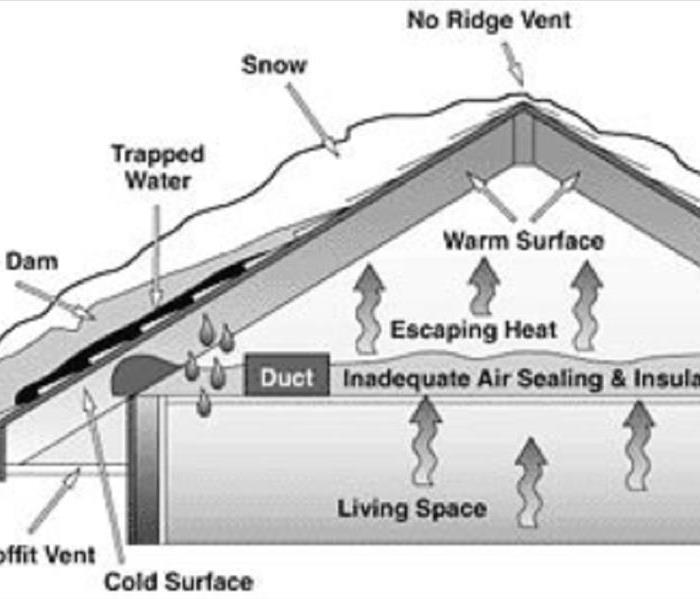 How ice dam's are formed.
How ice dam's are formed.
What is an ice dam?
An ice dam is a wall of ice that forms at the edge of the roof, typically at the gutters or soffit, and prevents melting snow from draining off.
What causes ice dams?
For an ice dam to form, 3 things must be present:
1) Snow on the roof
2) Higher portions of the roof’s external surface must be above 32°F
3) Lower surfaces must be below 32°F
So how do you fix an ice damn?
There are several fixes, but only 1 cure to fixing an ice damn: a combination of better sealing, insulation, and venting in the attic and eaves.
One way to fix an ice dam is to take a box fan into the attic and aim it at the underside of the roof where water is actively leaking in. This targeted dose of cold air will freeze the water. Seal all points where warm air leaks from the living space into the spaces immediately below the roof sheathing.
You can also purchase a roof rake and remove the snow from the front of your roof. This is a very good way to remove ice and snow if you live in a one story home. However, if the snow is heavy and wet, it can be difficult to remove the snow with the rake.
You can also insulate the living space well enough to prevent conduction and convection of heat through the ceiling
Safety, Safety, Safety
Hacking away at ice dams with a hammer, chisel, or shovel is bad for your roofing and dangerous for you. And throwing salt on them will do more to harm to your plantings than to the ice. Instead, tap lightly with a blunt mallet. This is slow, dangerous work, so hire someone experienced at roofing. Even if you do it safely, the chunks of ice can take pieces of shingle with them.
There is a cure for ice dam's:
1. Seal all points where warm air leaks from the living space into the spaces immediately below the roof sheathing.
2. Insulate the living space well enough to prevent conduction and convection of heat through the ceiling.
3. Vent the space between the insulation and the roof sheathing, so any heat that does leak through is carried away.
Remember, if an ice dam gets big enough, the water can back flow into your home. This can cause many different types of damage to your walls, ceilings, and insulation. If the ice dam gets too big it can also pull the shingles off the roof.
Should you find ice dam damage to your home, we are here to help. Give SERVPRO of LaGrange Park/North Riverside a call at 708-240-4873, and we will be happy to help with all your water damage needs.
Frozen pipe prevention
12/12/2016 (Permalink)
Frozen pipes are a sure way to water damage in your home, but how do you prevent frozen pipes in the winter? Our friends at American Family Insurance share some great tips on keeping your pipes from freezing.
The best way to prevent your home’s pipes from freezing is to keep them from being exposed to the cold. Here’s how:
- Cover exposed pipes in crawl spaces or attics with insulation sleeves.
- Re-route pipes to an inside wall.
- Use caulking to seal cracks in the foundation or walls that let cold air in.
- Disconnect garden hoses and turn off the water supply to spigots.
- Keep cabinet doors open below your sinks to allow warm air in.
Other ways you can winterize your home from frozen pipes remove all the hoses from the outside water supply. Once you have drained and stored the hose away, open up the outside valve. This will allow the remaining water to drain and allows the pipe to expand without breaking. You should also consider a pipe sleeve to install over the outside water line to insulate and keep ice from forming.
The American Red Cross gives great ideas on preventative action during cold weather to consider to keep your pipes from freezing as well.
- Keep garage doors closed if there are water supply lines in the garage.
- Open kitchen and bathroom cabinet doors to allow warmer air to circulate around the plumbing. Be sure to move any harmful cleaners and household chemicals up out of the reach of children.
- When the weather is very cold outside, let the cold water drip from the faucet served by exposed pipes. Running water through the pipe - even at a trickle - helps prevent pipes from freezing.
- Keep the thermostat set to the same temperature both during the day and at night. By temporarily suspending the use of lower nighttime temperatures, you may incur a higher heating bill, but you can prevent a much more costly repair job if pipes freeze and burst.
- If you will be going away during cold weather, leave the heat on in your home, set to a temperature no lower than 55° F.
There are many way to keep your home safe from winter pipe breaks. Please feel free to reach out to SERVPRO of LaGrange Park/North Riverside at 708-240-4873 if you need any help with your home.






 24/7 Emergency Service
24/7 Emergency Service




















